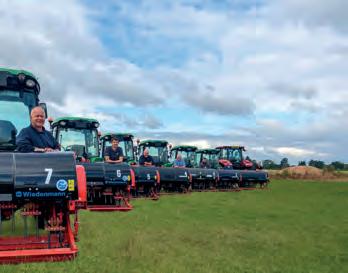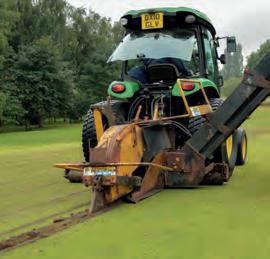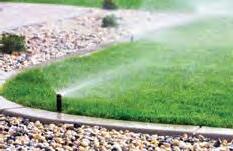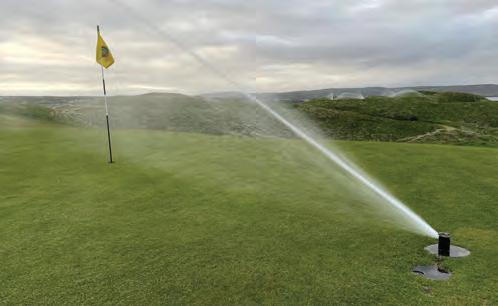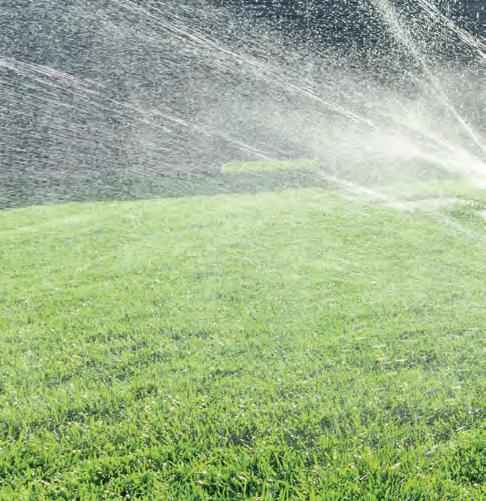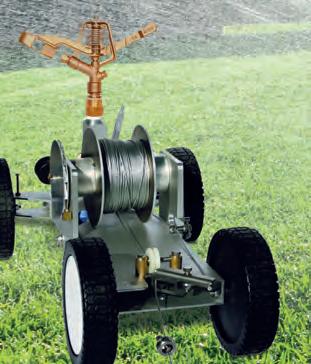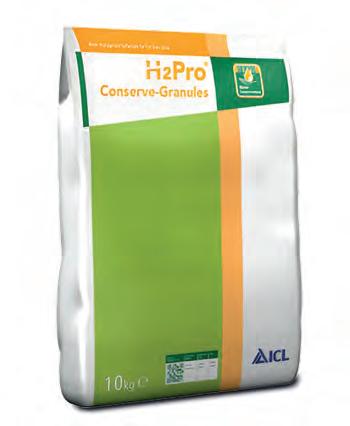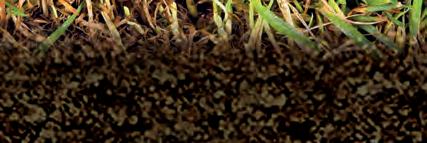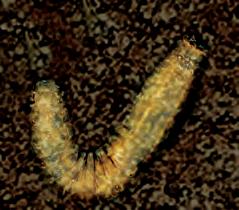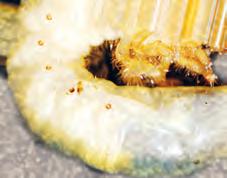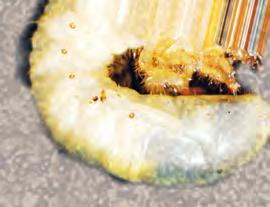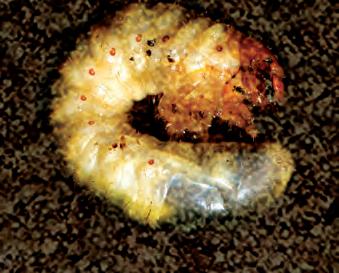PITCHCARE



OUR INDUSTRY MUST LOOK AT BECOMING CLEANER, QUIETER AND SAFER. WE INVESTIGATE EFUELS AND ZERO-EMISSION ALTERNATIVES
how beneficial nematodes protect sports pitches
Using soil temperatures to determine application timings
staff shortages and budget constraints. what is the solution?


























XL combinesa newact


































Trophy XL combines a new active ingredient, Arylex™, with established herbicide technology, offering broad spectrum weed control in turf. Its advanced formulation acts quickly on actively growing weeds and is highly effective against persistent weeds like plantain and clover.






Editor Kerry Haywood














I read a lot of criticism and negativity surrounding our industry on social media, which is both relevant and prevalent in how many of you feel - salaries, working conditions, budgets, committees… I could go on - the list seems endless!
However, I think it’s important to step back and acknowledge the initiatives and opportunities available too.
There has been an influx in my inbox over the past few weeks from associations and companies alike, launching events and offering opportunities across the country. BIGGA and The R&A have recently announced the first-ever Championship Agronomy Experience, where a team of ten successful members will provide tournament support during five of this year’s biggest championships. These greenkeepers will gain experience in elite championship preparation and, although the opportunity is only available to a small number, the ongoing initiative will provide opportunities for many more over the coming years.
The GMA is launching one-day events across the country (GMA Connect), bringing grounds professionals together at a regional level and providing handson insights through seminars, live demonstrations, and practical workshops.
GroundsFest Academy recently launched with a free educational day on seed science - marking the beginning of a new era in free, hands-on education. In addition, the Bernhard Academy has expanded its educational offering by becoming a training provider for the Golf Club Managers’ Association (GCMA) Advanced Management Programme.
That said, there is no doubt the greenkeeping and groundcare industry is under pressure. Demand for high-quality playing surfaces is at an all-time high, yet we’re facing staff shortages and budget constraints like never before. Bradley Tennant addresses whether seasonal and part-time staff could be the answer, from page 28.
Also in this issue, we have no fewer than four technical articles: Soil Surfactants (p.22), Summer Disease Vigilance (p.62), Beneficial Nematodes (p.38), and Autonomous Shift (p.78), plus Top Tips, Wellbeing and much more.
Enjoy the read and hopefully, some favourable weather over the next couple of months.
Kerry
t: 07973 394037
e: kerry.haywood@pitchcare.com



Park, Allscott, Telford. Shropshire TF6 5DY t: 01902 440270





No part of this publication may be reproduced without prior permission of the publisher. All rights reserved. Views expressed in this publication are not necessarily those of the publisher. Editorial contributions are published entirely at the editor’s discretion and may be shortened if space is limited. Pitchcare make every effort to ensure the accuracy of the contents but accepts no liability for its consequences. Images are presumed copyright of the author or Pitchcare, unless otherwise stated.
Printed by Buxton Press Advertising TSP Media t: 01952 234000
Climate

Basic
Using
Staff shortages and budget constraints. What is the solution?
Key


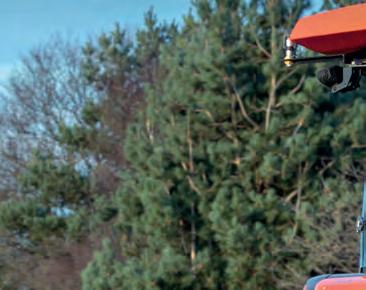








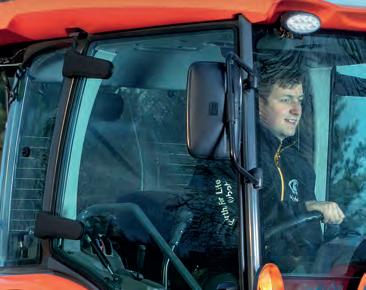



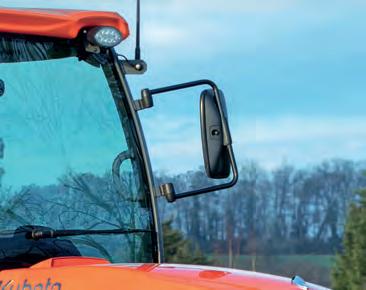



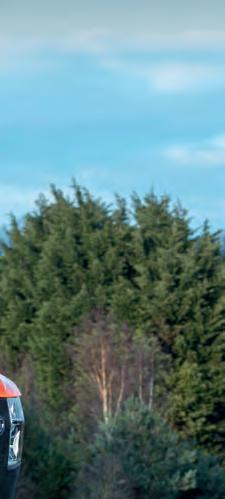


BIGGA and The R&A select ten greenkeepers for first-ever
The ten ambitious and talented greenkeepers will provide tournament support during five of this year’s biggest championships.
Ten BIGGA members will join the home greenkeeping teams for the hosting of this summer’s R&A championships, including The 153rd Open at Royal Portrush and the AIG Women’s Open at Royal Porthcawl. The greenkeepers will gain experience in elite championship preparation, working alongside the home greenkeeping teams and The R&A’s Championship Agronomy Team.
The volunteers will be on site at:
● The 153rd Open at Royal Portrush
● The Senior Open at Sunningdale
● The AIG Women’s Open at Royal Porthcawl
● The Amateur Championship at Royal St George’s and Royal Cinque Ports
● The Women’s Amateur Championship at Nairn
Each member is selected to participate at one of the championships, where they will be fully embedded into the home
greenkeeping team. The entire group will also assemble at Royal Birkdale in April for an education session and will be invited to attend The Open at Royal Portrush, where they will learn about course preparation and the staging of a major championship.
The successful BIGGA members selected for 2025 are:
● Ethan Walker, Enville Golf Club
● Steven Connolly, Ansty Golf Centre
● Duncan Sieling, The Richmond Golf Club
● Kyle Gauld, Whitecraigs Golf Club
● Geoffrey Seath, Broadstone Golf Club
● Christopher Szoradi, The Manchester Golf Club
● Adam Matthews, Minchinhampton Golf Club
● Jack Hall, Kilworth Springs Golf Club
● Dean Baily, Heswall Golf Club
● Bradley Taylor, Beau Desert Golf Club
For more information about BIGGA and its various activities including how to become a member, visit bigga.org.uk
The Grounds Management Association (GMA) is excited to announce the support of leading industry brands for its new regional event series, GMA Connect - a dedicated hub for grounds professionals.
Taking place in Bristol and Durham, these one-day events bring grounds professionals together at a regional level, providing hands-on insights through seminars, live demonstrations and practical workshops.
The 2025 events will focus on “Turf Management in the Current Climate” addressing the key issues facing the industry today.
GMA Connect is backed by headline sponsor Cramer, alongside ISEKI UK & Ireland, Campey Turf Care Systems, Fleet Line Markers, GKB Machines, Abundigro, Turfix and The Aquatrols Company, with more to be announced.
Next event: Wednesday 18 June 2025 – Durham County Cricket Club, Durham.
For more information or to register, visit thegma.org.uk/events
Connect ensures that expertise and solutions are more accessible than ever.
Sarah Hunter, Head of Events at the
The British Agricultural Garden Machinery Association (BAGMA) have teamed up with the UK paperless experts, Culverdocs, to launch a new digital solution for recording machinery installations.
Available to all valid BAGMA registered installers, members and non-members, the introduction of the ‘Paperless Solution’ signifies the end of long-winded, handwritten triplicate forms which often end up torn or muddy at the end of a handover and installation session.

“This software is a real gamechanger,” says BAGMA General Manager Nick Darking. “We’ve all been there – out in a muddy field, in the rain trying to fill out triplicate forms on an install, and ensure that those who need a copy, have one. With so much of modern life now digitised, it made complete sense to develop a solution where paperwork could be completed with just a few clicks.”
To find out more, visit bagma.com




















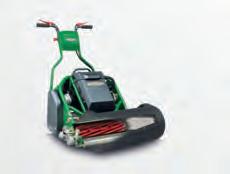












































































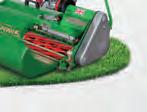



















The Bernhard Academy has expanded its educational offering by becoming a training provider for the Golf Club Managers’ Association (GCMA) Advanced Management Programme.
As part of the Golf and Hospitality Operations section, the Academy will deliver the Golf Course Management for Golf Club Managers module, providing club managers with essential insights into the complexities of golf course maintenance.
Sami Strutt, Education Director at the Bernhard Academy, commented: “This programme will help club managers better understand greenkeeping practices and the strategic importance of supporting their turf teams.”
“A strong relationship between the club manager and the course manager is vital – not only for course conditions, but for aligning business
goals with playing performance and understanding what makes the on-course side of the business tick,” she added.
The course will explore key themes including principles of turf management, environmental sustainability, golf course strategy and planning, stakeholder communications, capital planning, and budgeting. Aimed at decision-makers such as general managers, operations directors, and heads of golf, the programme provides essential insight into the operational demands and financial realities of managing a golf course – the main asset of any golf facility.
For more details on the GCMA Advanced Management Programme and to secure a spot visit gcma.org.uk/gcma-ampcertificates
Jack McMillan recently passed away at the age of 92
Those who knew him well described Jack as a canny Scot, unflappable and philosophical but with both feet planted firmly on the ground. Across a career spanning seven decades, he was forthright in his belief that better education would advance the greenkeeping profession and, crucially, he was willing to do something about it.
Jack was hugely influential in the formation of BIGGA and in raising the profile of greenkeepers. He was also a fantastic gentleman, seemingly always accompanied by his remarkable wife, Rita.
In 1993, Jack received an MBE from the Queen at Buckingham Palace in recognition of his lifelong commitment to advancing the greenkeeping profession.

Read BIGGA’s full tribute to Jack here: bigga.org.uk/news-listing/remembering-jackmcmillan-founding-father-bigga.html



















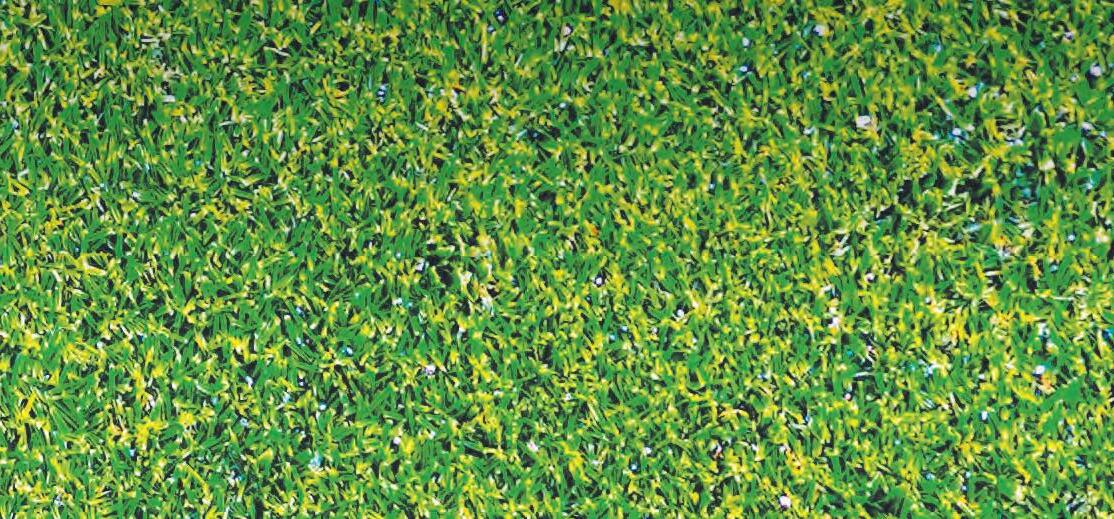







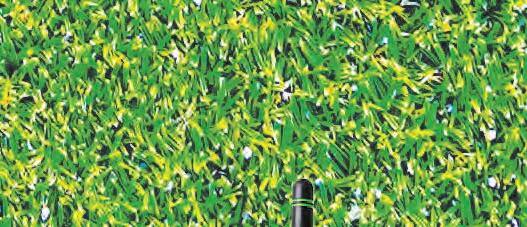



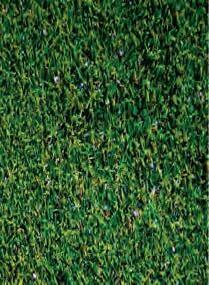




The Toro Tempus Decoder System The





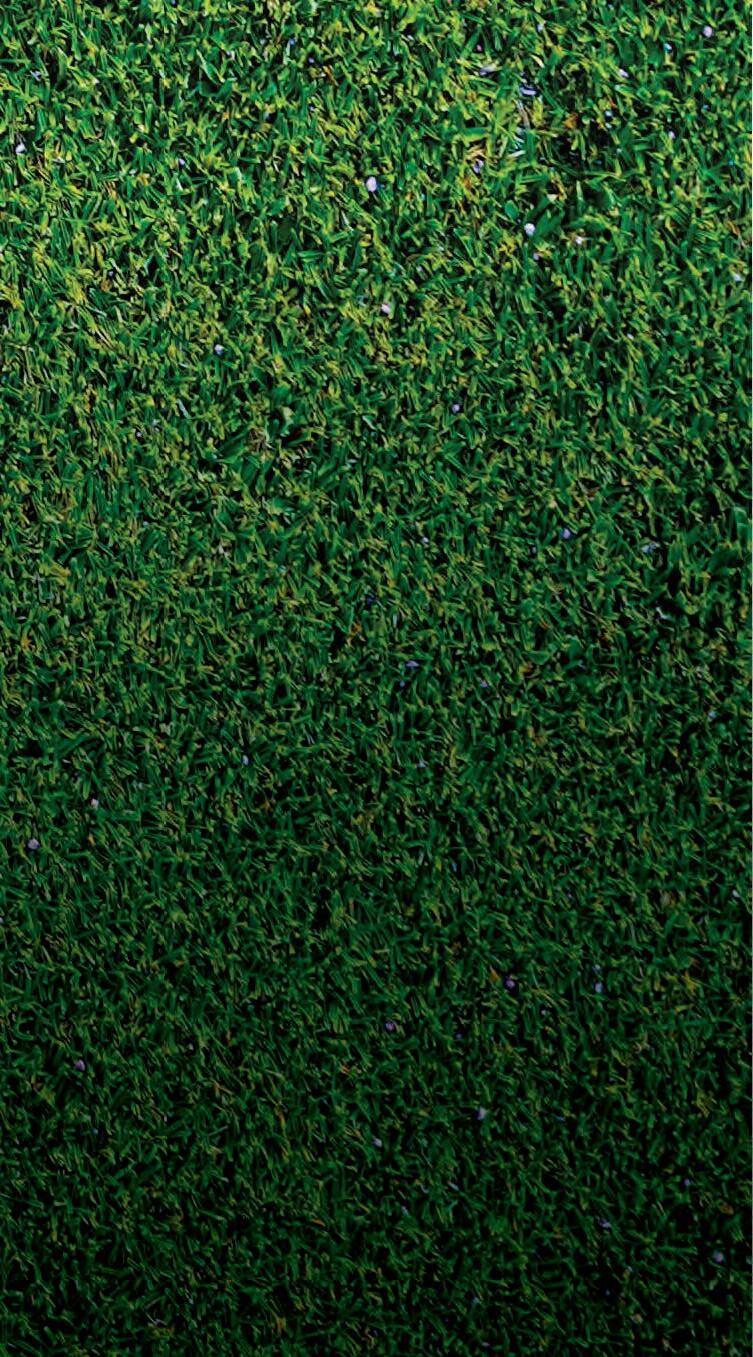



In a quest to improve the environment, our industry must look at becoming cleaner, quieter and safer. We investigate eFuels and becoming CO2 emission-free through the use of lithium battery technology.

Climate change is having a noticeable and growing impact on sports turf management across the globe!
The quest for net zero is filtering through ever more facets of business and personal life. Shorter term impacts on that mission may upset the journey temporarily, but those developing fuels of the future are taking the longer view.
Developing fuels of the future is a complex mix of energy efficiency, engine tolerance and sustainability.
Some of the major machinery and equipment players in the groundcare sectors have set out their criteria for advancing to net zero and take a worldview of its benefits for planetary health.
Ultra pure petrol, with little if any of the chemicals harmful to operators and machinery, is gaining ground in the UK. Diesel may have become almost a dirty word in some quarters but biofuels fashioned from vegetable waste, tailored to powering modified diesel engines, have been available for some time too.
It’s the world of electro fuels – efuels – that’s bubbling under, waiting for a kick start into commerciality across the board, that producers and partners globally are getting excited about.
Such like-minded advocates of ‘tomorrow’s technology’ are already assembled under the E-Fuels Alliance (EFA), a Hamburg-based interest group ‘focused on advancing the production and acceptance of synthetic carbon neutral fuels from renewable energy sources’.
Such fuels are “environmentally and climate friendly”, the EFA states, made as they are using electricity from renewable sources, water and ambient captured CO2. “Easy and versatile, they can replace conventional liquid and gaseous alternatives and, critically, can be used in all vehicles and heating systems powered by liquid or gaseous carriers.”
Efuels do not release additional CO2 when consumed “but are climate neutral in their use phase”. Compatible with current internal combustion engines, efuels can power everything from vehicles, machinery
and equipment to aircraft and ships. “Existing transport, distribution and fuel/gas infrastructures can all continue to be used,” the Alliance adds.
April’s news that 40% of global energy was generated from renewable sources would seem to signal the doorway to an efuels future is opening wider, and comes on top of earlier figures revealing a 23.2% share of renewables in global electricity generation in what is steady growth trends.
The Alliance numbers such power players as Stihl, Husqvarna, Kubota and Bosch in its ranks – committed to developing sustainability in-house, while helping their operator customer
1. Temperature extremes
● Hotter summers stress cool-season grasses (like Kentucky bluegrass or perennial ryegrass), leading to turf thinning or death.
● Warmer winters can disrupt dormancy, leaving turf vulnerable to diseases and pests.
2. Increased rainfall and flooding
● Heavy downpours cause waterlogging, compaction and erosion, making fields unplayable.
● Poor drainage can lead to root rot and fungal diseases.
3. Drought conditions
● More frequent droughts stress turf and reduce recovery time after use.
● Water restrictions make irrigation challenging, especially for large fields.
4. New pests and diseases
● Warmer climates allow pests and diseases to spread into new regions, increasing the need for pest control and potentially more chemical use.
5. CO₂ increase
● Higher CO₂ can increase growth in some turf species, but also may promote weed growth, altering the turfgrass ecosystem.
Below
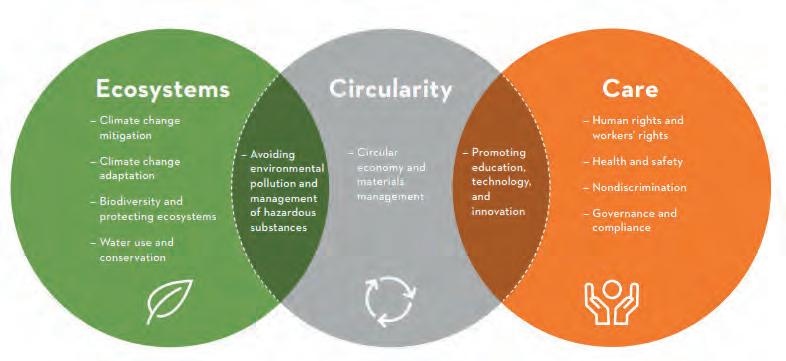
base seek it with the help of tools, equipment and machinery to mitigate climatic change.
The EFA promotes the advantages of efuels to policymakers, the public, academia and the media. Backing the green energy transition, it advocates “technology openness, a clean hydrogen economy and scale-up of efuel production”.
Below April’s news that 40% of global energy was generated from renewable sources would seem to signal the doorway to an efuels future is opening wider.

● Climate change mitigation
As Stihl states: “Sustainability remains our compass, even in difficult times.” Globally, we’re in such times now, many would argue, but scaling up efuel production in part depends on governmental backing, and that appears to be lacking in Britain currently, one fuel producer told Pitchcare, with the focus firmly on an electric future.
That said, Stihl put in place a sustainability policy back in 2016, from which it has created its sustainability strategy, including a 2021 report that identified four key environmental aspects it would address:
1. Switching grass types
● Transitioning to more droughtand heat-tolerant species.
● Using genetically modified or hybrid varieties for resilience.
2. Improved irrigation
● Installing smart irrigation systems that respond to soil moisture and weather conditions.
● Harvesting rainwater and recycling greywater for irrigation.
3. Soil management
● Enhancing soil structure with
organic amendments to improve water retention and drainage.
● Aeration and topdressing to combat compaction.
4. Integrated Pest Management (IPM)
● Monitoring and early intervention strategies to manage pests without over-relying on chemicals.
5. Sustainable practices
● Reducing mowing frequency and focusing on sustainability.
● Exploring carbon sequestration in turfgrass systems.
● Circular economy and materials management
● Avoiding environmental pollution
● Protecting biodiversity
The larger the player, the more expansive the mission to act to protect Earth’s wellbeing it seems, and fuels play a pivotal part in the corporate playbook.
By 2030, Stihl for example aims to cut fossil fuel (natural gas and oil) consumption by 40% across the group, compared with 2019, with one of its far-reaching projects being ‘climate neutrality’.
The importance of fuels in moving to a net zero position can be judged by startling statistics from Dr Andreas Rigling, forest ecologist and professor of forest growth and global change at ETH Zurich public university.
“Forests absorb two billion tonnes of carbon from the atmosphere and the soil every year,” he reports. “About 50% of that is stored in the biomass in the forest soil.”
Continued deforestation around the world threatens those carbon sequestration statistics, creating greater urgency in moving to carbon neutral technology.
The range of alternative power sources to traditional petrol and diesel is extensive –biofuel, ethanol, methanol, hydrogen, coal-derived options, electricity, natural gas, propane and synthetic transportation fuel.
Of these, only hydrogen is the simplest, most basic renewable fuel generated by electrolysis and is carbon free, offering potentially the lowest emissions from the combustion process – one reason why so much attention is devoted to exploring the feasibility and economics of

large scale production.
Global manufacturer Kubota has already dived deep into hydrogen-based technology. Another player tying its colours to the climate neutral, sustainable future mast, it has joined the Allianz Hydrogen Engine group, while developing its 3.8l 85 kW hydrogen engine, which eliminates CO2 emissions, it says.
Meanwhile, all Kubota engines, including stage V models, can burn non-fossil, paraffin-based options complying with European standard EN 15940, including gas to liquid and hydrotreated vegetable oil (HVO).
Efuel technology has sprung up in Britain with the commissioning of a demonstration plant in

Bicester by Zero Petroleum, founded and headed by former Formula 1 executive Patrick Lowe.
Already attracting investors, Zero operates with purely private funding, generating fuel from hydrogen and CO2
One of its backers is Anglo American Oil Company (AAOC) which already distributes Aspen alkylate fuel - gaining ground with the turfcare sector because of its extremely low benzene, olefin and aromatics content, chemicals known to harm health, and zero ethanol, an alcohol that can age engines prematurely.
“When we met up with Paddy Lowe, soon after he had founded Zero Petroleum, it was obvious






to us that his vision of how to keep ICE (Internal Combustion Engines) engines alive was one that was very exciting,” says AAOC managing director Anders Hildebrand. “So exciting in fact that we decided to invest in the company.”
“Paddy has done a great job in attracting new investors and in building a prototype plant in Bicester that is now producing eFuels from hydrogen and CO2.”
He questions the policy of wholesale support for electric vehicle development, although the government recently relaxed tight targets imposed on the auto industry for the switch to EV in light of President Donald Trump’s tariff impositions.
“Despite this amazing technology, the UK government has decided to put all their eggs in the EV basket,” Anders adds, “meaning vehicles still in good working order are retired prematurely.”
“This is bonkers, because the vehicles can be fuelled by a true carbon neutral fuel instead. It’s a reflection of the throwaway society that modern economics promote,” he argues.
“If the UK government had supported this new technology with development grants, Zero Petroleum for example, would have been up and producing considerable amounts of efuel that could have been blended into current road fuels.”
“Even more astonishing is that efuels attract the same amount of petrol tax (£0.5295 per litre) as standard pump fuels, while EV vehicles are heavily subsidised even though they wear the roads harder due to their increased weight.”
Article by Greg Rhodes.

The latest advice to government from the Climate Change Committee recommends the phasing out of petrol and diesel lawnmowers in order to reduce emissions.
Despite the widespread introduction of clean air zones in cities across the UK, new research obtained through Freedom of Information requests shows that highpolluting petrol-powered tools are still predominantly used in many of these areas, compromising clean air commitments.
Local authorities including Birmingham City Council and several London boroughs are still operating 100% petrol-powered tools within their clean air zones – at a time when cars are under increased scrutiny where emissions are concerned. The widespread use of petrolpowered tools can compromise air quality in
these areas, producing emissions comparable with some cars.
Petrol-powered tools – such as leaf blowers and hedge trimmers – are known to be just as, if not more, harmful to people and the environment. Emissions testing carried out by EGO Power+ and Millbrook found that some petrol-powered gardening tools are capable of emitting eleven times more carbon monoxide and four times more nitrogen oxide than a Ford Fiesta.
While the majority of tools being operated by local authorities are still petrol-powered, some




What percentage of the outdoor power equipment used within your clean air zone is petrol powered?
councils are progressing towards a cleaner, greener future with the adoption of batterypowered tools.
London’s Royal Borough of Kensington and Chelsea is leading the way in its use of battery-powered outdoor equipment, accounting for 100% of its tools. Councils in Sheffield and London Brent are also making promising strides, with battery-powered equipment now accounting for 85% and 90% of tools respectively.
“The sustainability challenge is something that faces every local authority across the UK, and the removal of highly-polluting outdoor power equipment has a role to play,” says Vince Brauns, Product Director at EGO Power+. “By focusing our research on councils who have made clear commitments to sustainability through clean air zones, we were keen to understand if councils have recognised the negative impact of petrolpowered tools, and how much progress has been made on their journeys towards a greener, battery-powered future.”
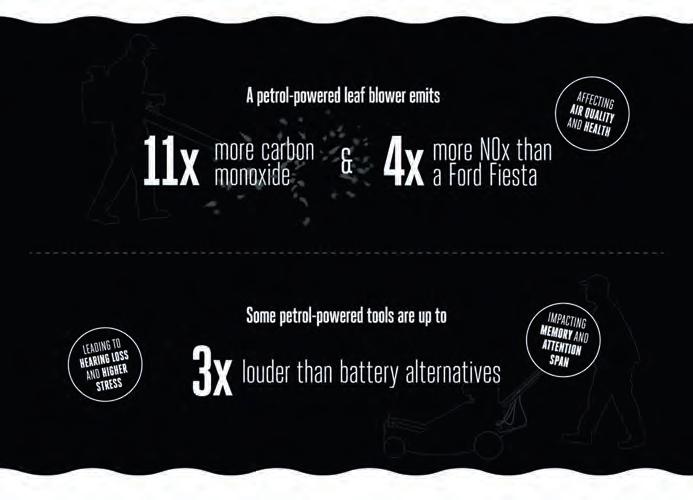
“While it’s encouraging to see a handful of councils have fully adopted battery power to maintain outdoor spaces, others still have a journey ahead of them. Birmingham City Council for instance still uses 100% petrol-power to maintain areas within the city’s Clean Air Zone, with the daily use of more than 60 tools emitting harmful emissions.”
“Modern technology makes switching to battery power easier than ever, unlocking a series of benefits for councils and their maintenance professionals. Better still, transitioning to battery power can be done in an easy-to-manage and cost-effective manner, maximising council resources while supporting the drive towards cleaner air and greater levels of sustainability.”
The research, carried out by EGO Power+,

saw Freedom of Information requests made to forty local authorities operating Clean Air Zones – including individual London boroughs. As these zones are proving to be effective by reducing numbers of high-polluting vehicles, the research aimed to understand if harmful, high-emission outdoor power equipment was still being used in these areas to maintain public green spaces.
As one of the world’s leading suppliers of battery-powered grounds maintenance equipment, EGO Power+ has supported local authorities and businesses large and small to transition to battery power – sustainably and
cost effectively. EGO’s technology adds social and environmental value while also driving down the total cost of ownership. For local authorities who face compliance and budgetary challenges, this offers a proven route to a sustainable and safer future.
Councils who have already adopted batterypowered maintenance equipment have unlocked a future that delivers improved comfort and safety to users, with tools that minimise noise and vibration.
To learn more visit: www.egopowerplus.co.uk/clean-air-zones

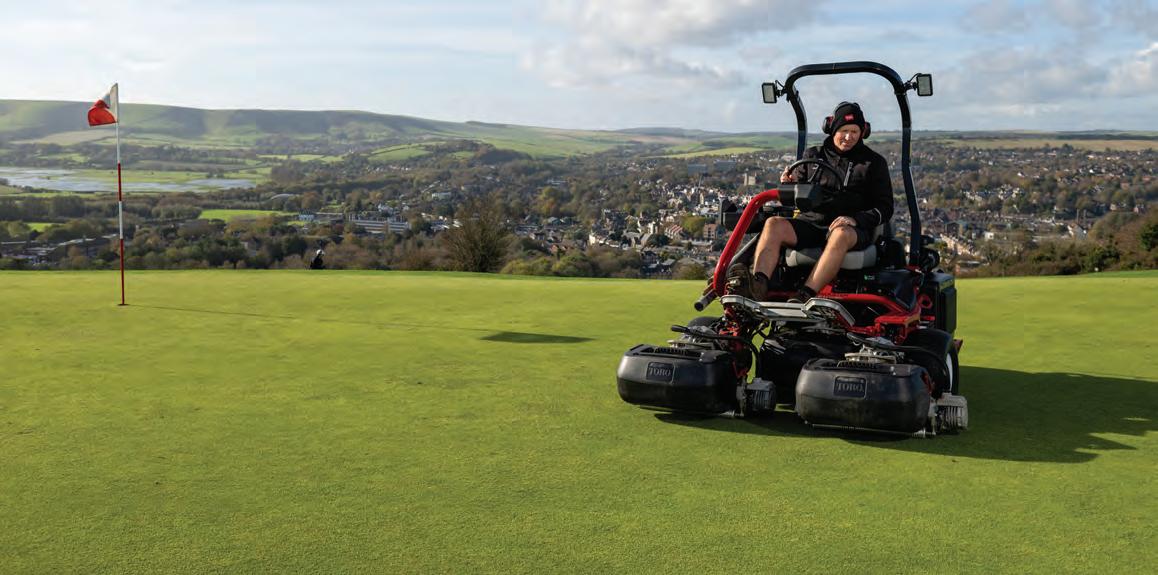

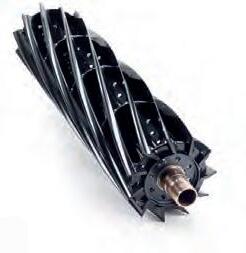

and healthiest turf. Every pass, a awless cut.
reesinkturfcare.co.uk



Bowring Park and Golf Course recently won the ‘Sustainable Project of the Year’ at the Golf Environment Awards. We spoke to Helen Paton about the positive sustainability changes implemented at the golf course.
Helen shared the story of how the course achieved its awardwinning status: “In 2022, oneday took over the lease of Bowring Park with a clear vision; to transform its golf offer while opening the course to new audiences.”
“At the time, this 92-acre site was losing a quarter of a million pounds a year and change was essential.”
“We’ve now completely re-imagined how municipal golf can work as a thriving, selfsustaining space. Bowring is proof that sustainable regeneration can breathe new
life into a golf course and make it work for communities, businesses, and the environment.”
“My role has focused on partnerships and how they can benefit the course in the long term, bringing together people we can collaborate with and learn from - whether that’s the local council, universities, golf courses, local businesses, The R&A or children’s golf charities. We want golf to be the driving force. Professors from Liverpool John Moores University have visited the course to explore ways we can work towards making it net zero. That isn’t a quick fix, but we are planning for the future.”
Sustainability can appear both simple and


complex, as Helen explained: “We have used the golf course and park to bring sustainability to life. This includes rewilding areas with native plants, improving biodiversity and creating natural habitats such as bug hotels and bird boxes. It’s also about educating people – every hole on the golf course is named as one of the UN sustainability development goals. So whilst people play, we’re educating them about the importance of sustainability.”
“We need to look at the bigger picture of sustainability in golf. We are installing solar panels and electrical vehicle chargers, but sustainability can also be about introducing golf to new people to keep it thriving. We need to remove as many barriers as possible to bring more people into the game and greenkeeping.”
oneday has a 125-year lease on the golf course and Helen outlined their early goals: “In 2024, we launched grow: The Sustainability Campus - an ambitious project designed to make Bowring Park and Golf Course a showcase for environmental responsibility. We now encourage other business to visit and learn from us, while also enhancing the golfing experience. For this to succeed, we need to focus on the small steps
Bowring is the oldest municipal golf course in England, which presents unique management opportunities. Helen continued: “We are accessible to everyone and that’s because we don’t have lots of rigid rules and regulations. Given the status of the course, we want to encourage a diverse range of participants to get involved – for instance: players can wear whatever they like and they can play, even if they’ve never tried golf before. It’s been wonderful to welcome new people to the course. We recently hosted sixty-five local school children in the pouring rain to show them what golf can be.”



golfers. But, when putting our award submission together, it made me so proud to think about how much we’ve achieved.”
within a larger initiative. Our vision goes beyond simply recruiting more staff or increasing membership; sustainability projects are at the heart of everything we do.”
“Even when it comes to water management, we’re consulting Liverpool John Moore’s University to consider what to do with the volume of water on the course.
Ecologists and flood resilience experts have advised how we can improve drainage in a sustainable way, and keep the course open year-round.”
When asked about the nomination for ‘Sustainable Project of the Year’, Helen recalled: “Owen James from England Golf mentioned that we’ve been disrupting traditional golf course management. We’re never going to fit the mould of traditional golf courses - we don’t have committees and we don’t have a dress code for
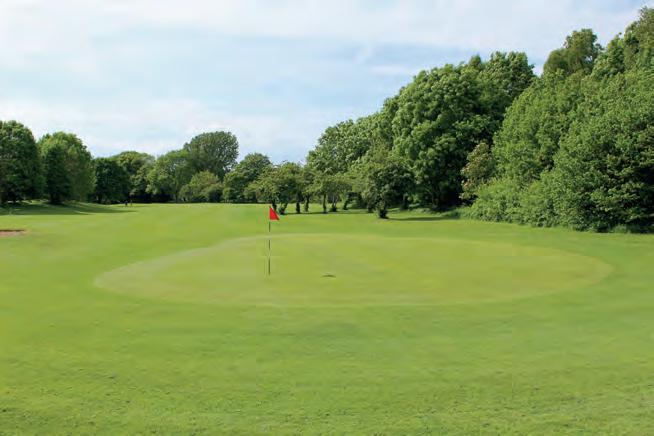
“Sustainable practices have become part of our day-to-day work, yet people are recognising how different our approach is. The whole team has brought a new culture to the Golf Course and Park, and we can’t wait to show everyone what the future holds.”
“Whilst it’s incredibly rewarding to have won the award, there’s so much more to come from oneday and Bowring Park. Golf courses around the UK have been contacting us to ask for advice and that is testament to the knowledge and expertise we have in our team.”
Receiving the award was a fantastic moment, but for Helen, the relationships built that evening were just as significant: “I had never attended one of those events before, and I walked away with valuable connections - people who are interested in the same things as me.That’s incredibly helpful because we can learn from one another and work together.”
Article by James Kimmings.
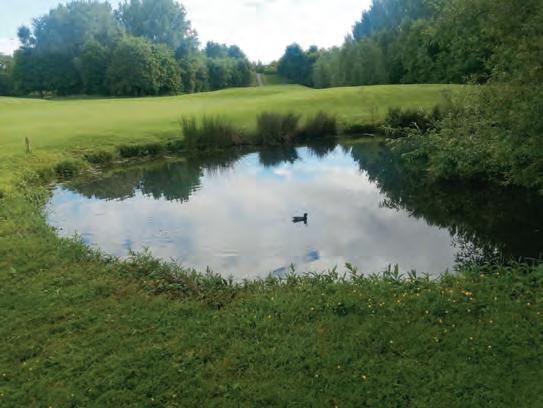


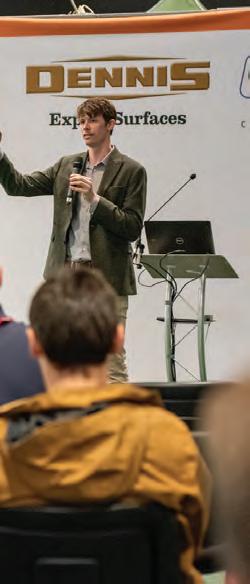
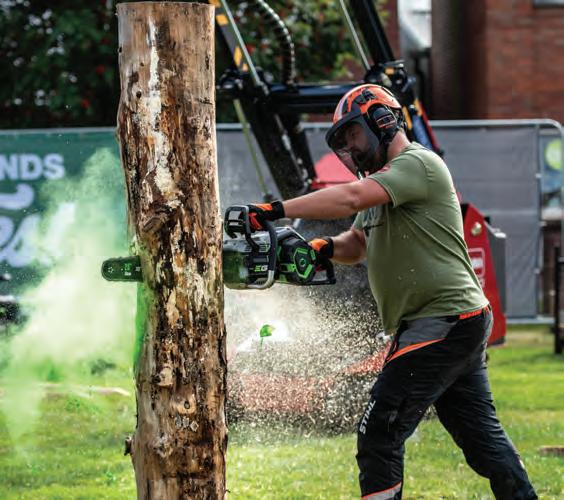








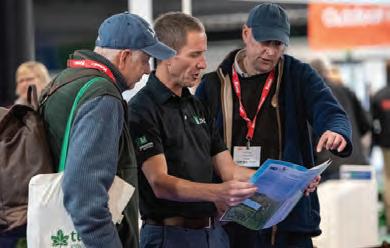






























Augusta fever has come and gone. However, the stress and pressure in turfcare continue to rise. James Matthewman, Deputy Head Greenkeeper at Maesteg Golf Club, outlines how he manages the growing expectations.
Has greenkeeping become more pressured in recent years?
Absolutely! The increasing expectations of golfers, coupled with the prevailing climate, have created substantial pressure on course management. The challenge of consistently delivering acceptable playing conditions under adverse environmental constraints makes it highly stressful to even achieve adequate standards of play. Does the amount of work involved in greenkeeping reflect the reward?
Yes, it does. Despite operating with a tight budget and limited resources, observing the condition of the golf course after a challenging week provides significant professional satisfaction. This sense of accomplishment stems from knowing that the achieved quality is a direct result of the considerable effort invested by both yourself and the team.
Have you felt stress in the job? What has caused this?
Yes, all the time! Working with an ageing fleet is extremely stressful. You can be right on top of things one minute, and it only takes one machine to go down - for example, the rough mower - and suddenly you have a massive snowball effect. You get pulled off your own job trying to fix it, so your own work doesn’t get done. Meanwhile, the rough keeps growing due to the breakdown, and even
when the parts eventually arrive, the rough is so long it puts further stress on the machine - which then puts even more stress on you!
Do you think that golfers should consider the work of greenkeepers?
100%. Golfers often don’t understand how much work it takes to maintain a golf course. Some do, but the majority think it’s just about cutting grass. While in summer it is a lot of cutting, there are so many more aspects to greenkeeping.
Have you ever experienced bad feedback at work? How do you manage this?
All the time! Keeping 500 members happy is really tough. Some golfers want very fast greens, others prefer them slow. Some like clearly defined grass areas, while others want everything closely mown. It’s almost impossible to please everyone, so when we get complaints, we listen to what people want and try to find a middle ground where we can - but it’s often very difficult.
Do you think TV coverage of turfcare, such as The Masters or Premier League games, causes extra pressure?
Sometimes. I like to think that most golfers are educated enough to understand that Augusta and other top golf courses - along with top Premier League venues - are elite. That’s why top sporting events are held there. However, you do still get the odd few who’ll say, “They hand-cut the greens all

year round on that course - why can’t it be done here?” without considering the vast differences in staffing and available resources.
How have you managed stress and pressure in the job?
I try not to take work home with me. I also have hobbies outside of work, which help reduce my stress levels and cope with uncontrollable pressures. When I’m at work, I try not to panic or stress if I can help it. If something’s out of your control - for example, the weather - you have to remind yourself that you can’t beat nature, and better days will eventually come. It’s difficult sometimes, but maintaining a positive attitude is vital in the world we live in now.
How would you help someone else who might be experiencing stress? Should managers offer more consideration?
Communication is key with staff. If you feel that someone may be stressed at work, sit them down and talk to them. Reassure them, ask if they need help with anything. I think it’s incredibly important that managers stay vigilant to stress in the workplace. Needless stress can often be resolved relatively easily - but if left unchecked, it can be potentially harmful to someone who’s struggling. Personally, with how the world is now and how important mental health has become, I believe it should be mandatory for turf managers to take a course on managing stress and pressure at work.


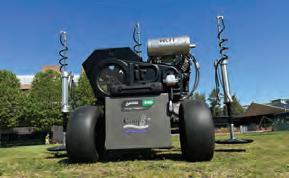
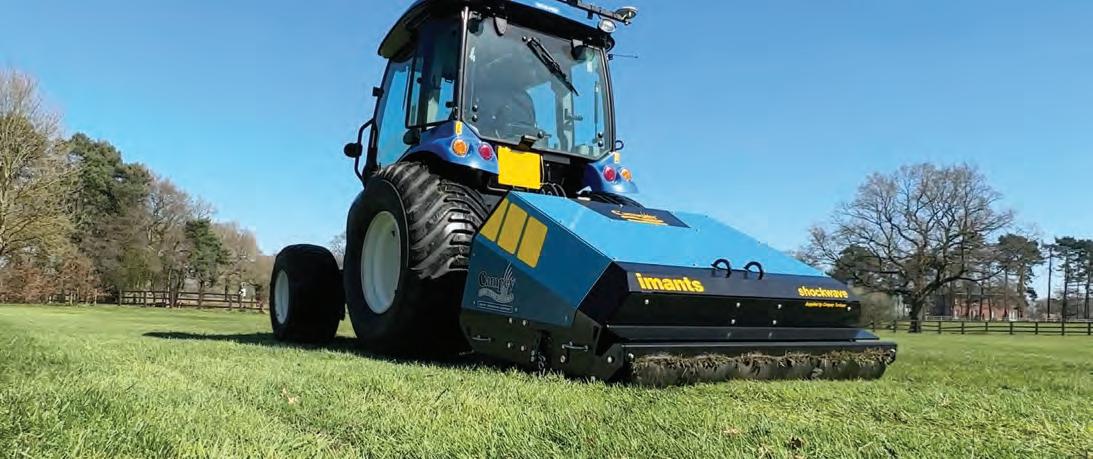
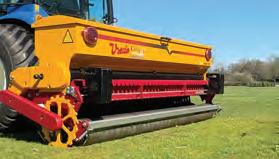
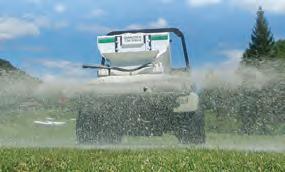

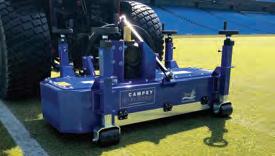


Could there be a better way to know when to reapply soil surfactants, so the product works as well as possible? Dr Christian Baldwin, The Aquatrols Company, explains...
Soil surfactants are essential tools for turfgrass professionals implementing turfgrass management programmes. They offer many benefits such as; reducing localised dry patch formation, enhancing soil moisture uniformity, improving water infiltration, increasing root growth, minimising nutrient leaching and boosting turf physiological fitness. Given these advantages, soil surfactant chemistries vary widely and include formulations such as straight block, reverse block, methyl-capped polymers and alkyl polyglucosides (APG), as well as combinations of these chemistries. Ultimately the choice
of surfactant depends on turfgrass conditions, management goals and specific agronomic needs.
Using a calendar to time applications
Even though there are different types of soil surfactants (wetting agents), they all share one thing: they need to be reapplied based on a calendar schedule. Depending on the product, the label might say to reapply every few weeks or every few months.
But this raises a question - could there be a better way to know when to reapply, so the product works as well as possible? Recently, more people have started to investigate the use of a Growing Degree Day Model to help decide

the best timing for applying wetting agents, instead of using the calendar.
A Growing Degree Day (GDD) model is a simple way to measure how much warmth has built up in the soil over time. Plants need a certain amount of heat to grow, and GDD helps to track that.
To calculate GDD:
1. Take the day’s highest and lowest temperatures
2. Find the average
3. Subtract a base temperature - the point where plant growth stops. For turfgrass, this base temperature is usually around 6°C.
GDD models are commonly used in farming to help predict plant growth and decide the best times for carrying out practices such as fertilising, spraying or mowing.
Turfgrass managers are starting to use GDD models more often to help make better
decisions based on how the grass is actually growing, rather than letting the month or week dictate application timing. These models can help predict how and when the grass will respond to different treatments.
Right now, GDD models are mainly used in turfgrass management to help determine timing for applying plant growth regulators, making fertiliser applications, controlling weeds, managing annual meadow grass seedheads in spring, and predicting when diseases might appear.
Why use a Growing Degree Day model?
There are two main reasons why these models are popular:
1. They’re easy to use. All you need are daily high and low temperatures, and you can plug these into the model using a recommended base temperature based on what you are trying to achieve.
2. GDD tracks heat buildup, and temperature is one of the biggest factors that affects how grass grows. When temperatures get too high, it can throw off the plant’s balance between making and using energy. This can lead to problems like poor root growth, less nitrogen uptake, and a higher risk of disease.
In the end, using GDD makes a lot of sense - because grass responds to temperature changes, not to calendar dates.
GDD = 2 TMAX + TMIN

• Data-driven decision making
• Cost efficiency
• Improved turf health
• Adaptability to climate variability
The effect of temperature on surfactant breakdown in the soil
Even though soil surfactants are widely used, there hasn’t been much research on how temperature affects how long they last in the soil. To explore this, researchers at the University of Minnesota ran two studies.
In the first study, Sam Bauer looked at how well a surfactant applied in the autumn held up into the following spring. He found that in spring (about five months later), water moved into the soil faster in treated areas compared to untreated ones, showing that the surfactant was still working.
Building on that, Ryan Schwaub, also from the University of Minnesota, studied how soil temperature affects water repellency, aiming to better understand how temperature plays a role in surfactant performance.
The results showed that soil temperature seemed to affect how quickly water soaked into the soil (measured by WDPT), but it’s still unclear if temperature really affects how long surfactants last in the soil.
At the University of Arkansas, Eric DeBoer studied how applying surfactants in late autumn
impacted ultradwarf bermudagrass during winter. Like the University of Minnesota’s results, his study found that late-season surfactant applications helped the grass recover better, reduced winter damage and improved how fast water moved into the soil in spring. However, the results weren’t always the same every year.
Overall, there’s no clear answer yet on how temperature affects surfactant breakdown - likely because there hasn’t been enough research, and the variability of soil make-up adds to the complexity.
To better understand how temperature impacts the longevity of surfactants, The Aquatrols Company has launched a new research project. The initial phase of this study is being conducted at the University of Tennessee, with plans to expand it across various climatic zones. This research explores how different surfactant types and application rates influence soil moisture retention and turf performance, particularly in the spring following winter
To track what’s happening in the soil, moisture sensors were placed at different depths to collect daily data. This will give a detailed look at how moisture levels through the profile change over time.
The research began in late 2024 and will continue through 2025, wrapping up in 2026. Stay tuned for updates and results!

Right now, there are three soil surfactants with GDD models that are available to the public on the website greenkeeperapp.com. While it’s still a small selection of products, it’s a positive step toward better timing of surfactant applications for improved results.
These models are still in testing (Beta) mode, but ongoing research is working to expand them to include more types of surfactants and different application rates. Over time, with more data and research, these models will
become more accurate and even more helpful for turfgrass managers around the world who maintain golf courses, sports fields and other turf areas.
For more information, please contact your local Aquatrols Account Manager.
The Aquatrols Company develops technology to optimise soil – waterplant interactions. Aquatrols strongly believe we should take responsibility to protect our soil and water environment by delivering high performing, safe and environmentally responsible surfactant products for our end users, distributor partners and the wider community.


ECHO Robotics’ premium quality robot mowers are at the cutting edge in terms of innovations and features.



• GPS-RTK navigation and Wisenav® technolog y meaning no boundary wires or multiple reference stations
• Web portal and mobile application



• Weekly mowing capacity up to 225,000m2 per robot
• Day and night operation in all weathers
• Genuine cost savings guaranteed
• Unrivalled daily coverage


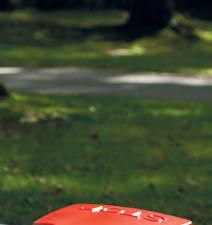





• Anti-scalp discs with a cutting height of 10-100mm




Find out how we can transform your course management: Visit echorobotics.com • Call 01789 490 177 • Email info@fgmclaymore.co.uk

No two starts to the calendar year are the same nowadays, with significant variability in temperature and rainfall. That’s why recording basic climatic data (rainfall, maximum and minimum air temperature) is a must.
Using this temperature data inputted into a growth model such as Growth-Degree-Days (GDD) allows us to make comparisons yearon-year.
Comparisons that can help us understand where our turf is and, above all, provide data for communication to management and members alike.
Below is the GDD formula I use to make growth comparisons:
(Max daily air temp + Min daily air temp) / 2 – base temperature (6°C base temp) = GDD
Note - I use 6°C as my base temperature because that’s when we see active grass growth, American models use 0°C. GDD has no units of measurement, it is simply a scale to quantify the potential of the grass plant to grow vs. air temperature.
In the table left, we compare 2025 with 2024 so far, using rainfall and GDD (6°C base temp) data from a location in Oxfordshire.
So, using this basic data we can already see some big differences year-on-year, we are approximately 50% drier y.t.d and had a particularly dry month in March. Not great if you have overseeded unirrigated areas and

April 8th, 2025
Max temperature = 15.5°C Min temperature = -0.4°C
Inputting those numbers into the GDD formulae gives us ; (15.5+-0.4)/2 – 6 (base temp) = 1.55 GDD
Now, I work on 4 – 6 GDD as indicative of good growth, so in this case, although we have warm day time temperatures, the effects of cold nights and grass frosts result in a GDD figure that is indicative of a very low growth rate.
Again, an invaluable aid in communication to show why the current weather isn’t completely ideal for greenkeepers and groundsmen/ women alike, even though I think we would all take a dry start to the year over a wet one!

visit: www.weatherstations.co.uk
Send your questions for Mark to: editor@pitchcare.com




















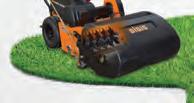











































































































A fantastic addition to your team! Here's why... and staff
The greenkeeping and groundcare industry is under pressure. Demand for high-quality playing surfaces is at an all-time high, yet we’re facing staff shortages and budget constraints like never before.
Full-time staffing models are becoming harder to justify year-round, so how do we adapt?
One of the best solutions we have is to use seasonal and part-time staff. Done right, this can help clubs and venues save money and stay flexible with a stronger, more dynamic workforce.
Matching workloads to seasonal demands
One of the biggest advantages of seasonal and part-time employment is that clubs and venues can match their staff levels to workload demands.
We know that maintenance needs fluctuate throughout the year. Spring and summer are peak growing periods that require intensive care, but winter can be busy too, requiring specific skill sets with project-based work. Instead of carrying full-time staff year-round, clubs and venues can scale their workforce up during busy periods and down during quieter months. This means they’re using their

resources where they’re needed most without unnecessary financial strain.
Beyond routine maintenance, part-time staffing also supports tournament and event management. When clubs host high-profile competitions, they need extra hands to keep everything running smoothly. Clubs can bring in temporary staff to support these efforts, so permanent employees can focus on their core responsibilities without stretching themselves too thin.
Bringing in seasonal staff also gives clubs and venues the opportunity to introduce fresh skill sets. Many professionals in the industry have specialised expertise - capable of taking on the role of a spray technician, irrigation specialist, or mechanic, for example - who may not be needed full-time but can add immense value during busy periods.

This also creates an excellent opportunity for knowledge transfer. Part-time staff working alongside experienced professionals can contribute their own expertise while learning from existing team members. In turn, a club’s full-time employees expand their own knowledge, making the entire team stronger.
Plus, seasonal and part-time roles serve as a stepping stone for people interested in the industry but currently unable to commit to full-time employment. Students, career changers, and semi-retired professionals can gain valuable experience and potentially transition into full-time positions later. For clubs, this can only be a good thing, providing an ongoing pipeline of trained workers who already understand the organisation’s standards and expectations.
Alleviating burnout and reducing turnover
Another major benefit of integrating seasonal and part-time staff is how it can impact

Staff are more likely to leave for jobs with better hours if they’re tired and overworked
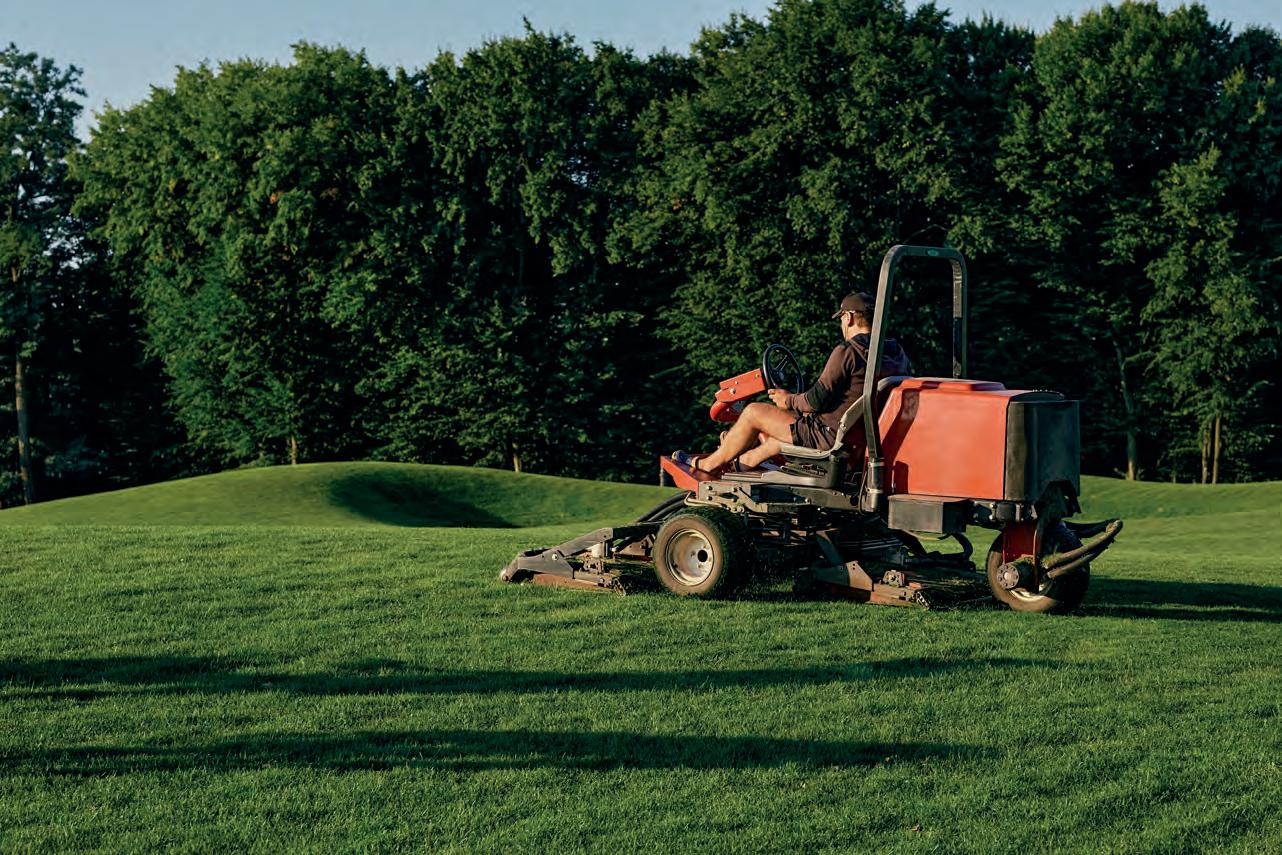
knows that the demands of a role in grounds maintenance can be intense, putting staff at risk of burnout - especially in peak season. Clubs can distribute workloads more evenly by strategically bringing in extra support, giving their full-time employees the breathing space they need to maintain high standards without overextending themselves.
Turnover is another ongoing challenge that

necessary. Staff are more likely to leave for jobs with better hours if they’re tired and overworked, but clubs can create a more sustainable work environment by supplementing the core team with flexible staffing solutions. If a club’s employees are happier and more balanced in their roles, they’re far less likely to look for opportunities elsewhere.
Although it clearly has a lot of benefits, there are still issues that can arise from bringing in parttime and seasonal staff.
Training and onboarding are a big concern, especially for smaller clubs or venues with limited budgets. Temporary workers still need to meet club standards, and that takes time and resources. But there are ways to reduce this issue by strategically approaching seasonal hiring - building a reliable pool of returning staff - so the investment pays off in the long run.
Consistency in quality is another issue that venues may face when hiring seasonal or temporary staff. Seasonal workers need to be capable of delivering the same standard of work as full-time employees, and that needs they need to be carefully selected and sometimes given additional training. But there are ways around this challenge, with mentorship programs and structured onboarding helping clubs maintain quality control while benefitting from flexible staffing models.

Finally, staff retention is something that some clubs may be concerned about. Seasonal workers often can’t guarantee their availability year-by-year because many are juggling multiple jobs or commitments. That means clubs need to think creatively about how to keep their seasonal staff engaged. A few possible solutions include offering incentives (financial or otherwise) and providing a clear pathway to full-time roles, not to mention the obvious: creating a positive work environment that staff genuinely want to return to.
It’s clear that we need to rethink how we structure careers in this industry. The traditional 7–3 workday model isn’t the only way forward, and using part-time and seasonal staffing can open the doors to a more diverse range of employees. This makes our industry more accessible and allows us to adapt to changing expectations as we move forward.
Using flexible staffing also gives us the opportunity to strengthen our relationships with educational institutions. Clubs and venues can work with colleges and training providers to create flexible pathways into the industry that aren’t limited to rigid apprenticeship models. This is an opportunity to bring in fresh talent and develop workers who are engaged and well-prepared.
The industry is evolving, and we need to evolve with it. If we want to maintain the high standards we pride ourselves on and keep our teams motivated and supported, flexible staffing solutions should be a key part of our strategy. It’s time to make seasonal and part-time staff a fully integrated part of our workforce, not just an afterthought.


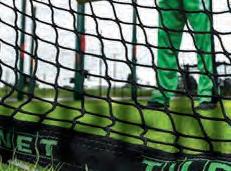
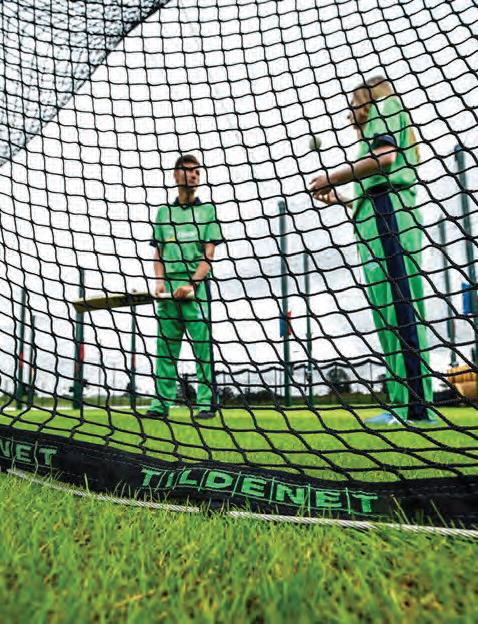



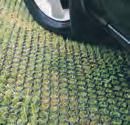
Gavin Kinsella Course Manager


Silva Sustainability Manager
Awarded the 2025 UK Environmental Golf Club of the Year at the 30th Annual Golf Environment Awards recently, this prestigious accolade recognises outstanding commitment to sustainable course management, conservation, and environmental stewardship.
Pitchcare spoke to Course Manager Gavin Kinsella and Sustainability Manager Claire Silva about the achievement.
Located in Richmond upon Thames, the club’s two 18-hole courses encompass over 50% natural habitat, including wetlands, acid grasslands, and wet woodlands, earning it Site of Importance for Nature Conservation (SINC) status.


The golf course has always implemented small conservation projects. However, the team has stepped up its efforts in recent years. Claire explained: “I don’t have a budget for my department and the amount we’ve spent on sustainability projects has been minimal. We started by getting our GEO Certification and began capturing baseline data; that was a valuable exercise because it made us realise how much we already do, but also how much more is needed.” Gavin added: “For the past fifteen years, golf courses have had to be ecologically minded. In this era, greenkeepers and course managers are very much aligned with wildlife, ecology and conservation.”
The key to success has been bringing the golf club together to work on conservation, Gavin said: “In the past, the conservation policy wasn’t communicated very well to members, and our work wasn’t connected to any other part of the club. Several years ago, Claire moved into her role, embraced the sustainability initiative and made it club-wide so that it is now under one umbrella. We used to focus on greenkeeperoriented conservation, but this didn’t have a

clear purpose. Now, we have our aims and we want to achieve things with purpose.”
Gavin suggested the importance of having a figure like Claire to guide the sustainability drive: “It helps us to have a central hub for conservation and sustainability at the golf course. In the past, I was like other greenkeepers, just getting on with the work. Now, with Claire as our point of contact, who is energised about sustainability, I won’t slip into bad habits. I always record my water, fertiliser and chemical use because that is important information for Claire.”
“Historically, we used to cut into all four corners of the property, under trees and between holes. One of our first initiatives was the eco-rough areas and we had to educate members; it wasn’t that we were being lazy and not cutting the rough; there was a greater aim to it. Some thought we were trying to save manpower hours and reduce wear and tear on machinery. They didn’t quite understand that we were trying to add to the habitats and conservation. Once they understood what we were doing, they got onboard.”
The club is also focusing on moving away from fully diesel-powered machines. Gavin said: “Unfortunately, we aren’t quite in a position to
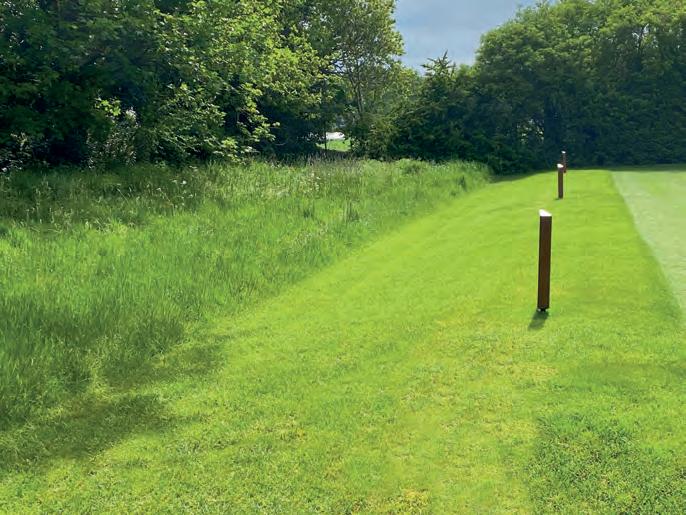
go fully electric, but we are investing in hybrid machinery, which is reducing the chances of hydraulic oil leaks on greens. Petrol hybrids are a significant improvement over diesel engines. We are now doing our part on the course in terms of managing and preparing conservation projects, but we are also working with the kitchen and the pro shop to create our own compost. The plan is to turn that over in the next few years and then return it to the golf course - a project very much owned by our Head Gardener who re-uses a lot of waste materials from the courses.”
Becoming award-winning
“The GEO dinner is an essential part of Harrogate week,” Gavin continued. “We have been contributors to that for several years. The engagement of the greenkeeping community has kept the awards going. To be a nominee is always a great occasion; you feel part of something bigger. You are up against great
Eco Rough to increase habitat for wildlife and reduce use of combustion engines for mowing.
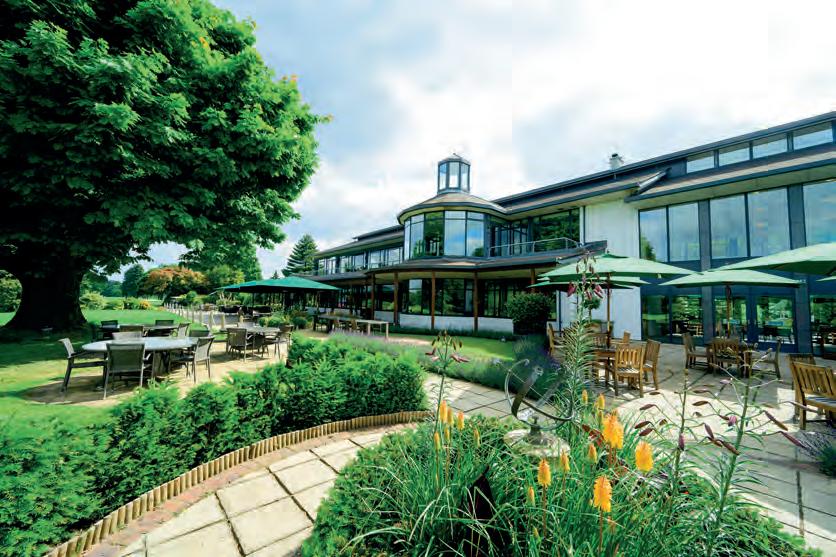
clubs, from whom you can learn throughout the evening. The teams confidence wasn’t sky-high about winning the award, but I felt that we had that secret weapon, which was Claire Silva. Winning was a fantastic feeling; we now have the responsibility to be a role model,” Gavin added.
Claire analysed how it felt to win the award, as well as highlighting the positive impact it
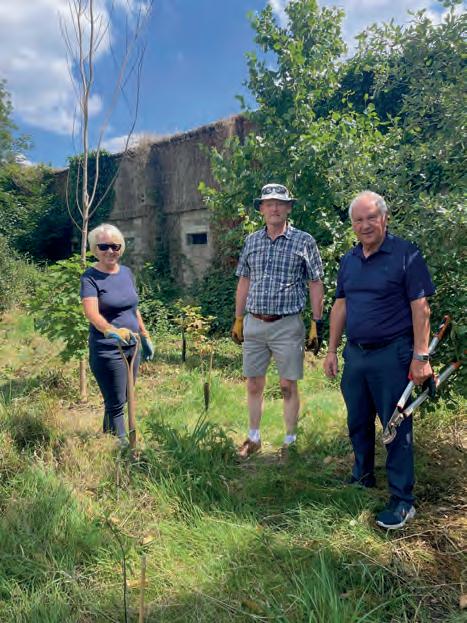
has had on the club: “It took a while for me to process that we had won the award. It was brilliant to get recognition for the hard work that has been implemented over the past few years.”
Claire outlined the work that has gone into becoming the 2025 UK Environmental Golf Club of the Year: “Our communication project has been the most successful venture. People don’t associate environment and conservation with






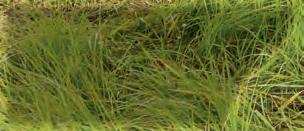
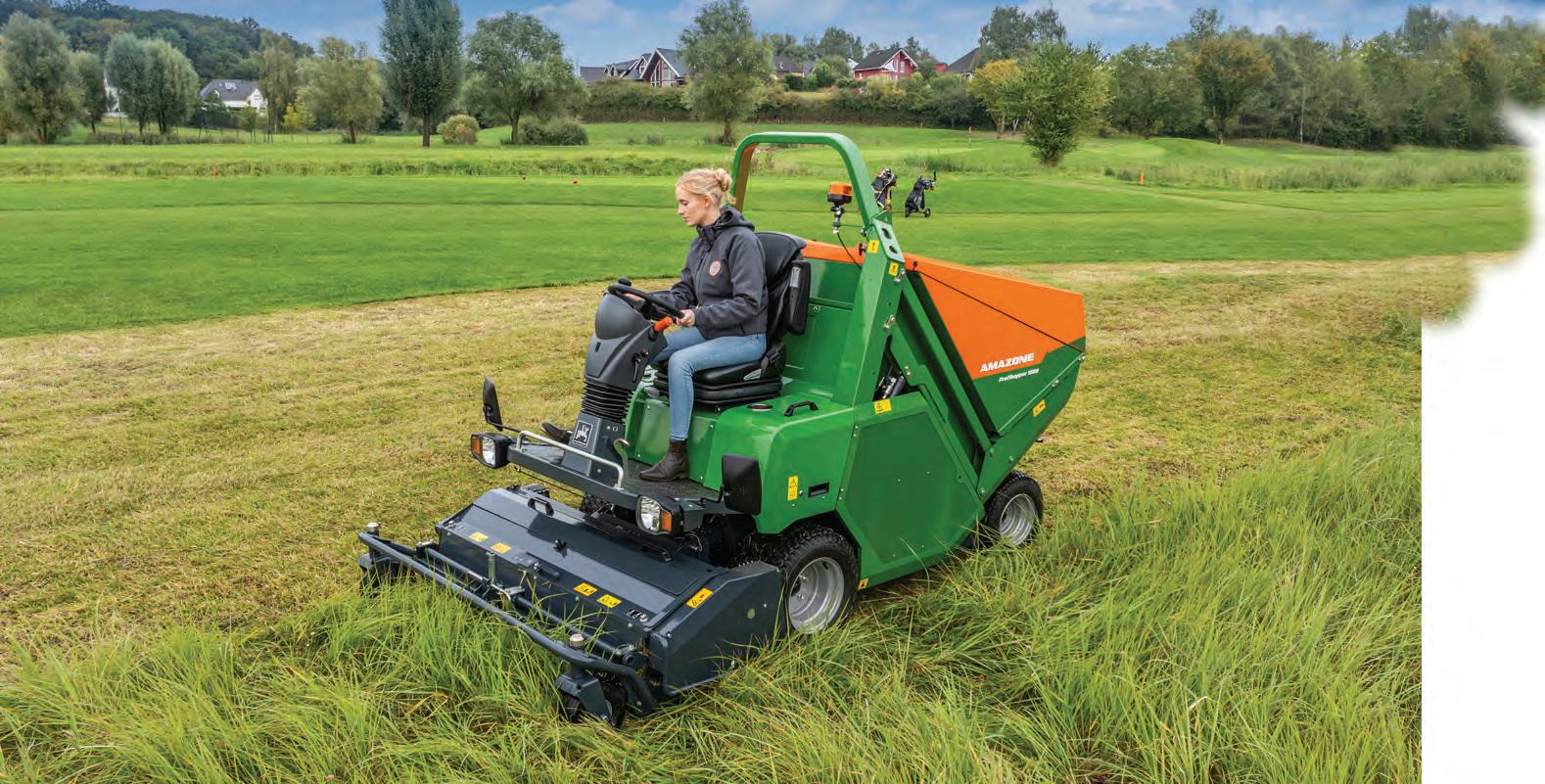










golf clubs. The target for last year was to look beyond our own estate and see how we can communicate with the members and the local community. Encouraging members to participate in activities like tree planting days and litter picking gets them involved in the project. We’ve also done school visits to educate about conservation and recently hosted a bat walk at the course.”



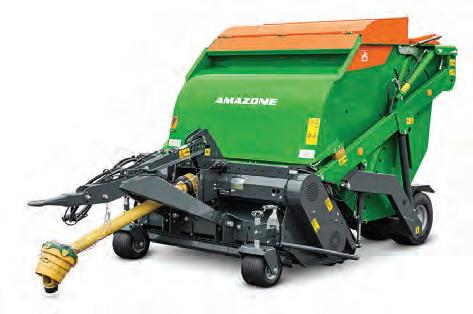

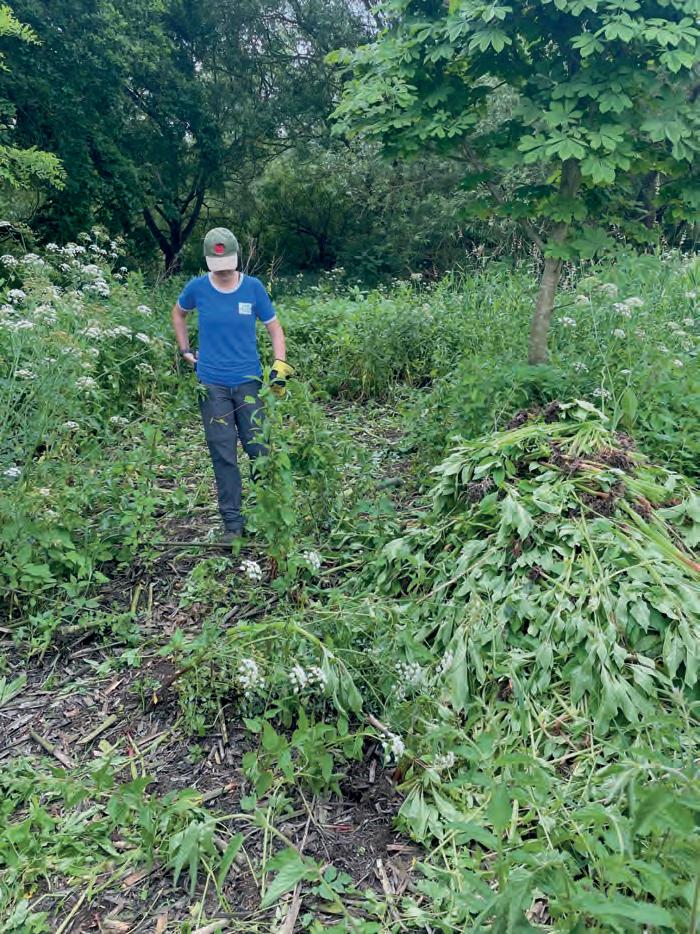
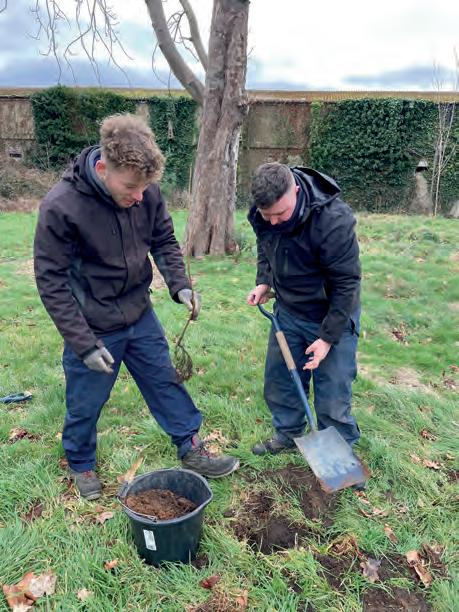
The amount we’ve spent on sustainability projects has been minimal
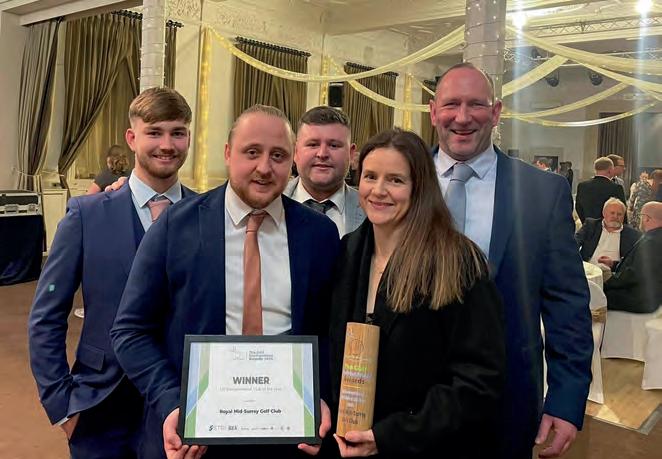
“We are now working with other organisations such as The Thames Landscape Strategy, as well as becoming members of the Biodiversity Action Partnership Group” commented Claire. “They work on action plans for species and biodiversity as a whole. With their support, we were able to carry out a Black Poplar project, where we planted fifteen trees to connect different sites. That was about what we can offer externally to the community.”
We’ve only hosted one bat walk and one school day and it would be nice to do more of those types of things in the future; it allows us to educate. We want to do more work with The Bat Conservation Trust, which has been conducting surveys across the site. It’s about being a small part of something bigger.”
Gavin concluded: “I would like to introduce more wispy grass species for those rough areas. We want to move away from the Yorkshire Fog grasses and bring in lighter grasses. We want a compact, dense base but with wispy tops. The refinement of our eco-rough areas will be a key activity in 2025.”
Article by James Kimmings.


















A Groundbreaking Nutrition Line that Enhances Plant Health while Minimising Environmental Impact & Honouring our Legacy

An innovative nutrition line o ering environmentally and economically smarter solutions through two proprietary technologies exclusive to the VerdeLNX range
Designed to signi cantly enhance nutrient absorption, optimising both foliar and root uptake of macro and micronutrients
Minimises nutrient losses by retaining nutrients higher in the soil pro le for longer. This maximises nutrient uptake by grass plants and reduces the risk of environmental issues caused by leaching

Highly eco-friendly, fully renewable, and completely biodegradable, leaving no trace or residue in the soil or water
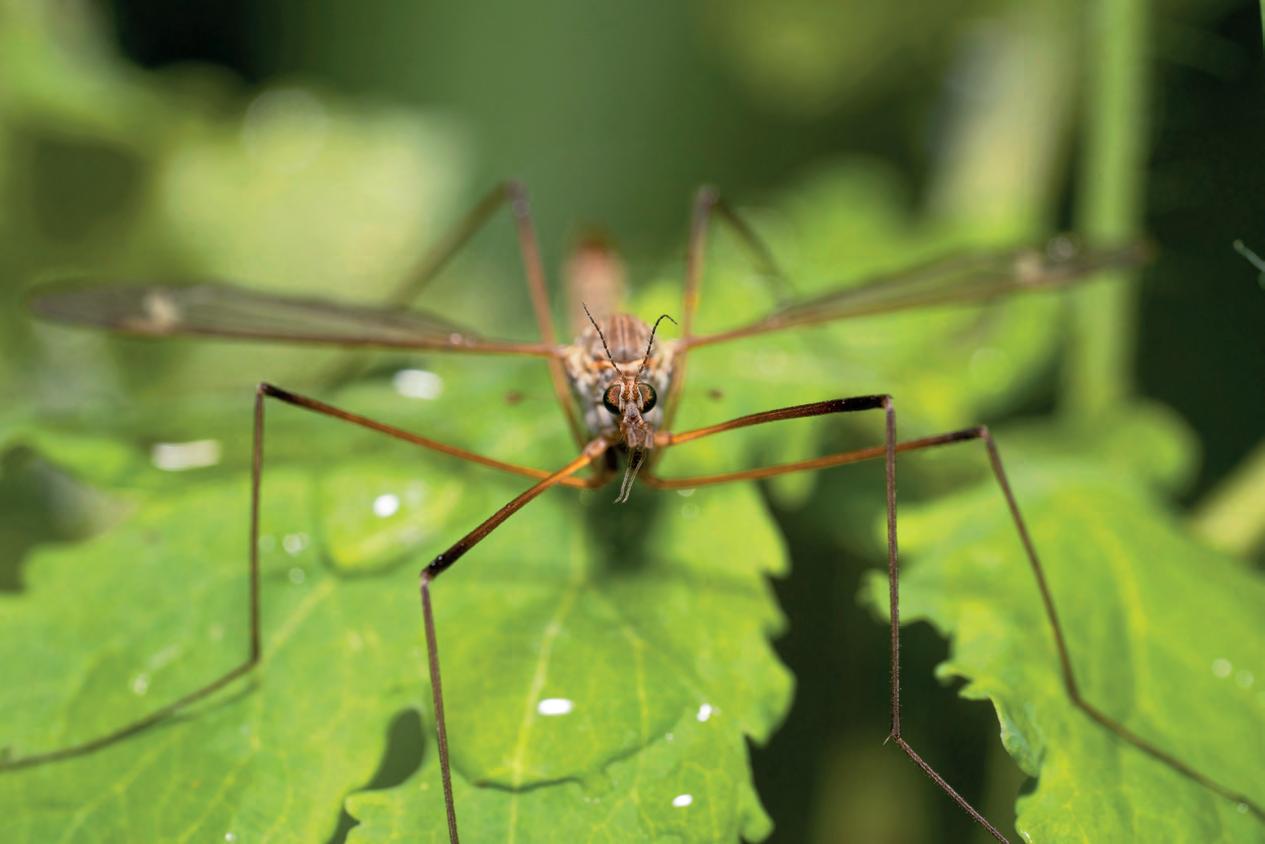
There is a natural and highly effective solution at work for unwanted guests like crane fly larvae (leatherjackets) and chafer grubs - insect-pathogenic nematodes.
Alush green surface isn’t just paradise for golfers and turf managers - it’s also a prime target for crane fly larvae (leatherjackets) and chafer grubs. These underground pests, as well as small mammals and bird life which search for them in turf, can cause significant damage, leaving behind patchy, unhealthy turf. The solution - insect-pathogenic nematodes. These microscopic warriors provide a safe, biological way to combat turf pests without harming the environment.
What are beneficial nematodes?
Also known as entomopathogenic nematodes, these tiny roundworms are natural predators of many soil-dwelling pests. They specifically target harmful insects without affecting humans or animals. Their menu includes, Leatherjackets (crane fly larvae), Chafer grubs and Weevils, caterpillars, fly larvae, thrips and other turf-damaging insects. Once introduced to the soil, nematodes actively seek out their prey, enter the insect’s body and release symbiotic bacteria that quickly overwhelm and kill the host. The

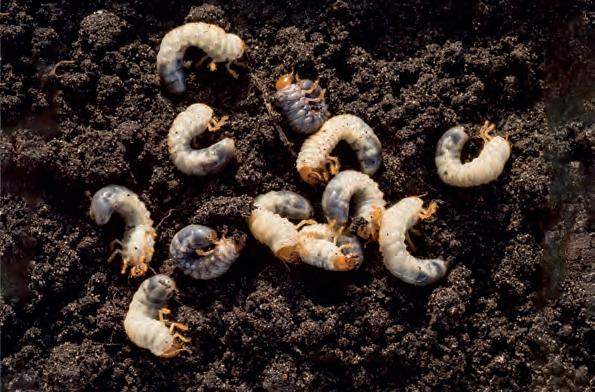
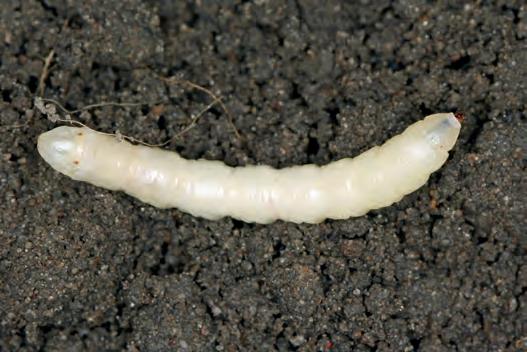
nematodes then reproduce inside the dead insect, creating thousands of new warriors ready to continue the cycle.
Why choose nematodes over chemical pesticides?
With increasing restrictions on chemical pest control, nematodes offer a sustainable, long-term solution. Here’s why they’re gaining popularity in Integrated Turf Management (ITM) programmes:
Eco-friendly and safe – Nematodes leave no harmful residues - making them safe for people, pets and the environment.
Long-lasting effectiveness – Unlike pesticides, which pests can develop resistance to, nematodes remain effective over time.
Self-sustaining – They reproduce inside the pest’s body, naturally maintaining their population.
Perfect for turf management – Compatible with most pesticides, nematodes fit seamlessly into professional lawn and turfcare programmes.
Currently, Acelepryn is the only approved chemical for controlling leatherjackets and chafer grubs in sports and amenity turf. As chemical options become more limited, biological control methods like nematodes are proving to be the future of sustainable turfcare.
How nematodes take down their prey
Nematodes hunt down their hosts using chemical signals like carbon dioxide and heat. Once they locate a target, they enter through natural openings (mouth, spiracles, or cuticle) and, depending of the nematode species, release bacteria (Xenorhabdus or Photorhabdus species) that cause septicemia in the insect, killing it within days. As the nematodes feed and reproduce, thousands of new ones emerge, ready to infect more pests.
This natural cycle continues as long as host insects are present, with nematodes remaining active for up to two weeks if soil moisture is maintained.
Eco-friendly formulation
Beneficial nematodes are delivered in sustainably packaged, water-soluble formulations that keep them dormant until application. This extends their shelf life for several months, ensuring effectiveness when needed. Thanks to recent innovations, Koppert has completely eliminated microplastics from its nematode products, further enhancing their environmental credentials. Once mixed with water, nematodes are activated and can be applied seamlessly using standard spraying systems.

Above Autospray Systems XAG P100 drone which can be used to apply nematodes.
The potential of beneficial nematodes in Integrated Turf Management (ITM) is vast. As the industry moves toward natural and sustainable pest control, these living solutions present a viable alternative to conventional pesticides.
Koppert and Agrovista are working closely with some of the UK’s top golf courses to implement sustainable pest control solutions. Among them is Woodhall Spa Golf Club in Lincolnshire, which applied Koppert’s Sportnem T against leatherjackets in autumn 2024.
Peter Moore, Director of Courses at Woodhall Spa, has been closely monitoring the results. “So far, we’re seeing good results, with no bird activity on the greens. While there is some bird and badger activity on other areas of the course, the greens have remained undisturbed, which I believe is a strong indicator that
Koppert Sportnem T is working effectively,” he reports.
Leatherjacket activity continues to be monitored, and Peter plans to extend nematode applications to other areas of the course, including the fairways, as part of a broader integrated turf management strategy.
This partnership highlights the growing shift toward biological pest control solutions in golf course maintenance, offering an eco-friendly alternative to conventional pesticides while maintaining high-quality playing surfaces.
By adopting nematodes, turf managers can apply a solution teeming with life, free from chemical residues, and fully aligned with the future of 100% sustainable amenity and sports turf management.
Integrating nematodes into turfcare not only enhances pest control but also supports broader environmental goals, helping the sector adopt eco-friendly land management practices that prioritise both turf health and biodiversity.
With the right timing and conditions, nematodes provide a natural, effective and chemical-free solution for maintaining healthy turf. By taking advantage of nature’s own pest control system, golf courses, sports pitches and lawns can thrive without relying on pesticides. So next time you see a perfectly maintained green, just remember - there’s an army of microscopic warriors working beneath your feet!


For optimal results, follow these essential steps when applying beneficial nematodes to control turf pests:
Select the right nematode species: Match the nematode type to your specific pest problem for maximum effectiveness.
Determine the correct dosage: Refer to product labels to calculate the required quantity based on infestation levels and treatment area.
Store properly: Keep nematodes refrigerated until application to preserve their viability.
Prepare a nematode suspension: Mix nematodes with water according to the manufacturer’s instructions.
Soil application: Ensure soil is moist but not waterlogged, and consider soil temperature for optimal nematode activity.
Foliar application: Maintain a relative humidity above 75% to enhance nematode survival and effectiveness.
Timing matters: Apply nematodes in low UV conditions, such as early morning or late afternoon, to prevent sunlight damage.
Even distribution: Use sprayers, irrigation systems or drones to disperse nematodes evenly across the treatment area.
Follow-up applications: Depending on infestation severity, repeat treatments may be necessary.
Monitor and adjust: Track results and fine-tune your approach based on pest activity and environmental conditions.

Ideal application conditions: High relative humidity (>75%), low solar radiation (early morning/evening), and soil temperatures between 15°C – 25°C.
Water quality: Safe mixing within pH 3–8 and EC up to 5 to maintain nematode effectiveness.
Enhanced penetration: To improve nematode movement through the turf, use an adjuvant like Agrovista’s NemaFlow.
Different species of nematodes are specialised for specific pests. Here’s a breakdown of the best ones for turf management:
Best for Hunting style Unique ability/ timing Works on
Steinernemacarpocapsae –The Leatherjacket Hunter (Koppert Sportnem T)
Heterorhabditisbacteriophora – The Chafer Grub Destroyer (Koppert Sportnem H)
Crane fly larvae (leatherjackets)
Chafer grubs
Ambush predator, lying in wait for passing larvae
Active hunter, moving deep into the soil to track down grubs
Senses carbon dioxide, targeting the insect’s breathing holes (spiracles)
Both surface-dwelling and below-ground pests
Chafer grubs do the most damage in autumn before burrowing deeper for winter

In 2022, the long-standing groundsperson at Bitteswell Cricket Club passed away suddenly. He had looked after the ground for over forty years. Co-Chairmen Nick Hutchinson and Richard Pearson have taken on the responsibility of managing the grounds.
For over forty years, Peter Smith had looked after the ground, which is annexed to the farm he owned and worked. Sadly, the club was left with a ground and square that no one else knew much about. This is a scenario that many clubs have and will continue to face. Co-Chairperson Nick told us about the challenges with this.
Peter had been reluctant to accept offers of help - partly because he loved the work so much and partly because, like so many groundsmen, he believed that if something needed to be done right, he was better off doing it himself. And he was certainly right!
Richard and I knew the basics - watering, feeding, rolling and cutting - but we had no idea when, how long or how much. We initially agreed
to take on the role for a “few weeks” to give the club time to adjust. There was a game at the weekend, and we knew Pete would have expected us to ensure it went ahead.
Richard had reached out to other local clubs and their groundsmen were incredibly willing to help. They came over, assessed our circumstances, got us ready for the weekend and gave us some pointers. They continued to check in and offer guidance in the weeks that followed. Whilst a groundsperson within a club might keep information close to their chest out of fear of interference, the willingness to share knowledge between clubs is a testament to the profession. From village clubs to county grounds, and from suppliers to grant bodies, we received the most generous support and encouragement, for which we are incredibly grateful. We made an

effort to be good pupils, and in return, they were happy to invest their time and knowledge.
In the first week, none of us even knew the quirky way to start the roller. A few days later, we accidentally let it run out of fuel on the outfield three hours before a junior match. Once again, people rushed to our aid.
In July 2023, the ground was fittingly renamed The Peter Smith Ground, marked by a charity match attended by hundreds of past and present members. There was some pressure, as we had deliberately prepared a brand-new track on the middle strip in his honour, but everything
went smoothly.
Three years on, we are still in the role. It’s fair to say we’ve really enjoyed it. It has been a challenge, but we’ve seen clear progress and set achievable goals along the way. We know this is something we will never fully master, but we now have the knowledge and confidence to handle most situations.
It’s also crucial that there are two of us on an equal footing so that either can seamlessly cover for the other. We have also involved other club members in specific tasks to ensure the workload is shared.










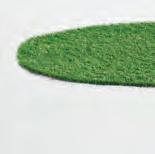
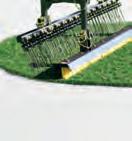


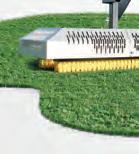






































































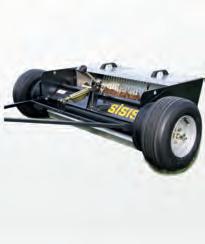
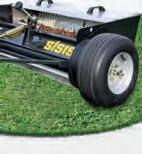



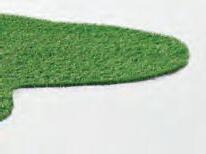




















To prepare for the future, we’ve compiled our own journal/manual, so that if the unthinkable happens - or when we eventually hand it over - the next people will have a head start with all the principles, instructions and contacts. Succession planning is a really important, yet often uncomfortable topic. Every club should consider what they would do in similar circumstances.
Village cricket may not be at the pinnacle of amenity turf management, but it is an essential part of the game and British culture, supported by thousands of volunteers.
How have you addressed the challenges?
The square we inherited had been well maintained for years, giving us a great foundation. We’ve made a few mistakes, but we’ve learned from them. The overwhelming advice has been not to fear trying something new.
We are somewhat susceptible to fungal attacks. Red thread initially alarmed us, but we now understand it can be managed with proper nutrition. We also have a great network to call on when something concerns us, and they have given us enormous encouragement and confidence.
Some of the equipment we inherited was incredibly old. Pete had a knack for keeping everything running, but we knew we would struggle. This left us vulnerable, so we identified what we needed and secured grant funding to help with some upgrades.
What work have you done to improve the pitch in recent times?
We quickly realised that watering the square would be one of the most time-consuming and tedious tasks. While our mains water pressure is adequate, we developed a simple pumped storage system that delivers the same amount of water in one-third of the time.
We also received early advice to increase our pitch grass length from 6mm to 10mm. This has made the pitches more durable and we hope that, over time, it will also enhance bounce.
Beyond the pitch and outfield, we have extended the car park, tidied up fencing, installed ball-retaining mesh, re-laid a patio area and updated signage. Creating a great first impression has been a priority, and our hard work is now paying off.
You are now ranked 11th in the Leicestershire League for pitch quality. How does that feel?
The pitch marks serve as motivation and we were pleased with our 2024 ranking. It’s definitely a batter’s pitch, and we now analyse other statistics, such as runs per over and overs per wicket, to compare with past seasons.
The Leicestershire & Rutland League is currently consulting on a two-tier restructure, where only clubs with Grade A or B pitches and facilities will be eligible for the upper tier. Based on the set criteria, we have been provisionally given an A Grade.
We want The Peter Smith Ground to be a key


reason for people to join. We are also now a regular venue for Leicestershire Over 60s and 70s matches.
Does more need to be done to help cricket clubs with maintenance and management?
Help and information are readily available, both in person and online. Every club should consider a ‘what if’ scenario for any longstanding groundsperson or club officer. While Pete loved
We thought we had completed our end-of-season work early, but days later, heavy rain and intense winds redistributed much of our seed, especially at the pitch ends. We reseeded by hand, and as we headed into spring, we reseeded some areas again.
In November 2024, we switched from bi-monthly granular to monthly liquid feed after advice from Mark Allen (Agrovista Amenity), and we are looking forward to seeing the improvements this brings. Given the budget constraints of a village club, there’s not much more we can do with the square, so in 2025, we are turning our attention to the outfield - starting with its first-ever Verti-Draining.
his work, we all felt a bit guilty for not having done more to assist him or look into equipment grants on his behalf.
If funding is available, every groundsperson will have a wish list to improve the ground - so go and secure it for them! Clubs need to take

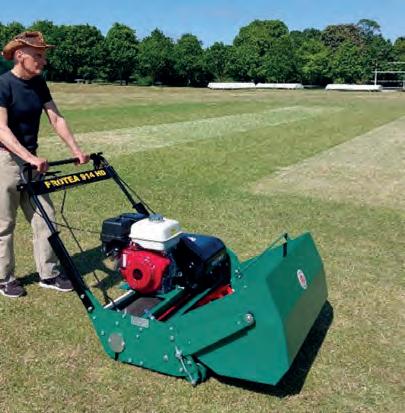

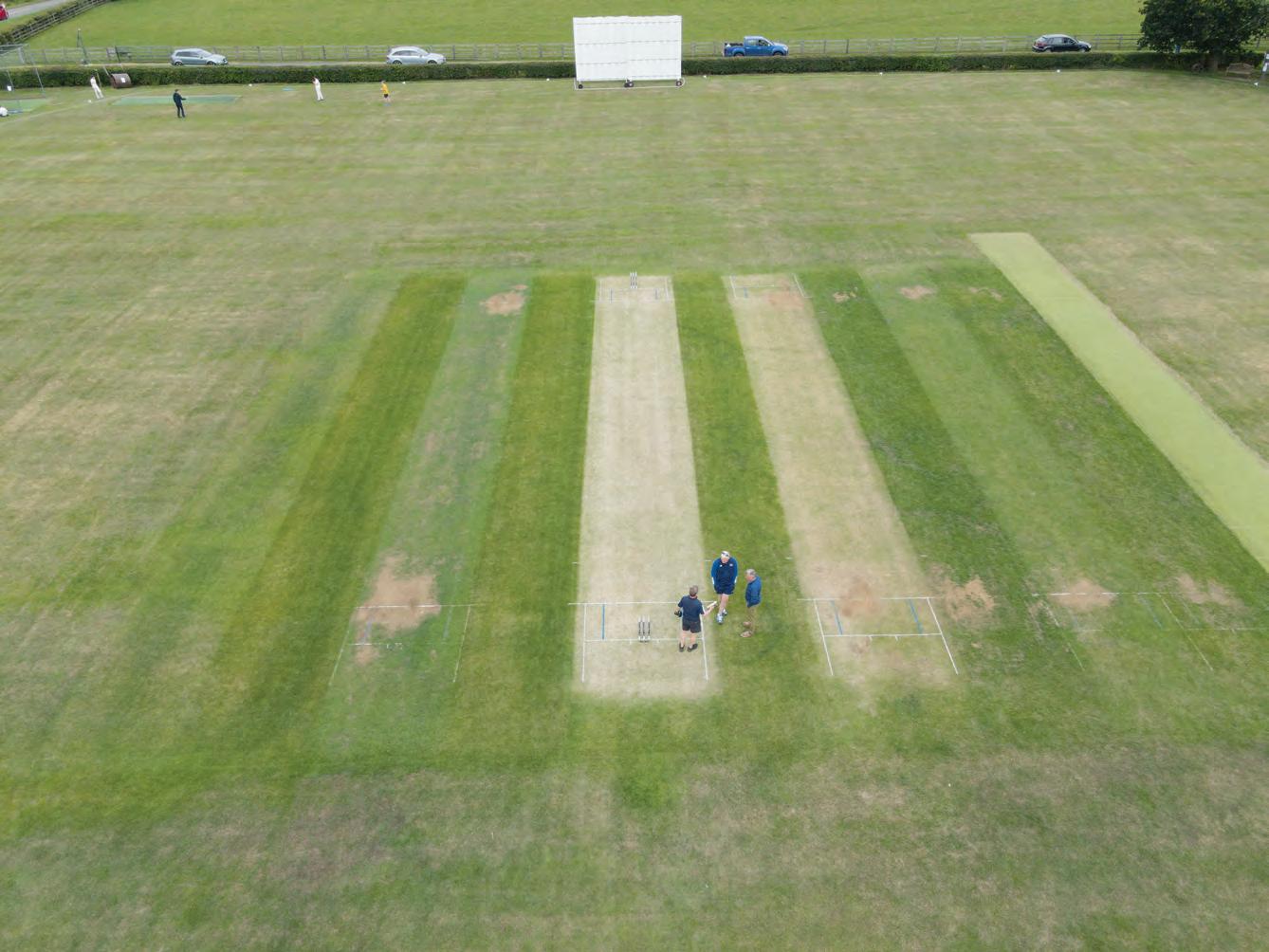
responsibility for their own future, and we hope our story encourages others to be better prepared.
Can you tell us about the management of the turf?
We have a ten-pitch square, but primarily use eight for matches, hosting around thirty-five games per season. We always work at least three weeks in advance. Being in a village location makes deploying covers during workdays challenging, so we plan carefully with an eye on
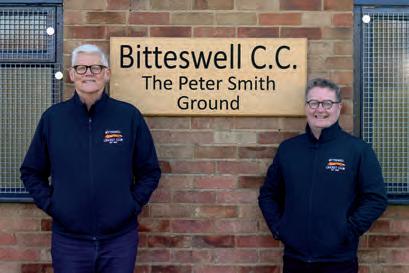
The pitches at Bitteswell have historically been a bit green. We became obsessed with achieving the classic straw colour, but we have learned that moisture content, rather than colour, has the biggest impact on playing
We started by having soil samples analysed, and now our nutrient programme feels more like a doctor’s prescription than simply ordering
We’ve now moved to liquid nutrients, and it’s great that many affordable products are the same as those used at Test Match venues.
How has your new role as Co-Chairperson helped with the management of the ground?
We felt we had a good handle on the ground and believed we could transfer some of that drive and enthusiasm to other areas of the club. However, we still need committee approval to spend money.
Having two chairpersons is a bit unconventional, but we come as a pair. Between us, we have excellent complementary skills - Richard has great contacts, vision and persuasive powers, while I see myself as being more analytical, pragmatic and experienced in achieving our targets.
Recently, we’ve turned our attention to marketing, social media and expanding our membership, especially among juniors. It can be quite challenging for village clubs to thrive in this sense, but the quality of our playing surfaces is definitely a selling point.
Over the past few years, we’ve been highly visible to the membership, sharing plenty of photos and a lighthearted, weekly Saturday morning pitch report video. All the players know us well, and we’re hoping they will buy into our strategy for the wider club.




























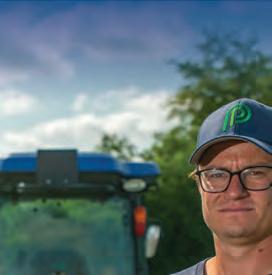

























Pete Newton from ReesinkUK Ltd discusses water management and what his experience has taught him about effective management techniques every turf manager should be considering during the stressful (for both operator and turf) summer season.

ete is in a unique position to explain the best practices as he started out as a greenkeeper, reaching his Master Greenkeeper status in April 2015, before changing career direction and specialising in the science of all things water and irrigation.
“Regular checks on a sports turf irrigation system going into and during the summer offer significant benefits, particularly in refining water management,” Pete stated. “We all appreciate efficient water usage is crucial for supporting both the health of the turf and sustainable agronomical practices and this is especially important during the warmer months when water demand is at its peak”.
Pete acknowledged, “Constantly monitoring, daily or even hourly, agronomic performance is paramount, and will give early warning signs to plant stress, which will instigate an investigation into the cause, or causes, of possible irrigation shortcomings.”
The benefits of ensuring an efficiently operated system are:
• Minimises water waste
Routine inspections identify and address issues like leaks, broken sprinkler heads, or misaligned nozzles and arc settings. Such problems can lead to overwatering in some areas and under-watering in others, wasting valuable resources.
• Promoting turf health
Factors like weather patterns, soil moisture levels and turfgrass type influence water requirements. By tailoring irrigation to these conditions, you can ensure the grass receives just the right amount of water.
• Enhancing uniform coverage
Irrigation systems are designed to provide even water distribution but wear and tear or mechanical faults can disrupt this balance. Consistent coverage not only supports the aesthetic appeal of the course or ground, but also prevents stress on specific sections of the turf.

• Improving system efficiency
Modern irrigation systems often include advanced features like soil moisture sensors and weather-based controls. Leveraging data from these tools, managers can make informed decisions, reducing water usage while meeting the turf’s needs.
• Environmental sustainability
Sustainable practices are increasingly important in sports turf management. By reducing water consumption and preventing runoff or flooding, clubs can minimise their environmental footprint. Regular maintenance also helps prevent contamination of nearby water sources caused by excessive irrigation or chemical leaching.
• Preventing long-term damage
Neglecting irrigation system issues can lead to compounding problems over time, such as root damage or soil erosion. Regular inspections enable proactive maintenance, ensuring that small issues don’t escalate into larger, more expensive challenges.
an
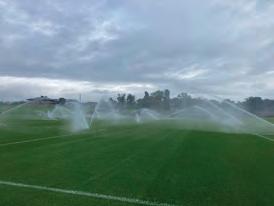
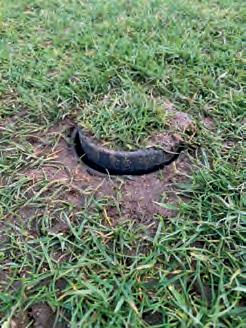


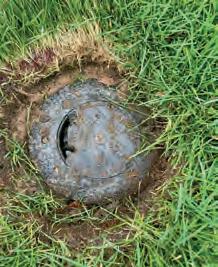

“Conducting regular checks on an irrigation system during the summer is integral to water management. By embracing this proactive approach, turf managers can achieve a balance between maintaining a pristine surface and practising responsible water stewardship,” explained Pete.
Here are Pete’s top tips for conducting your own investigation if you discover your system isn’t performing as it should:
1. Nozzle choice
Head to head coverage
Correct nozzle configuration
Correct stator in the bottom of the riser to replicate nozzle choice
2. Blockages
Check stator for blockages / debris i.e. rubber crumb or topdressing overspill
Check nozzles for blockages or damage
Check for blockages at the bottom of the sprinkler (where triple swing joint is screwed in)
3. Sprinkler body
Check for cracks or damaged heads regularly
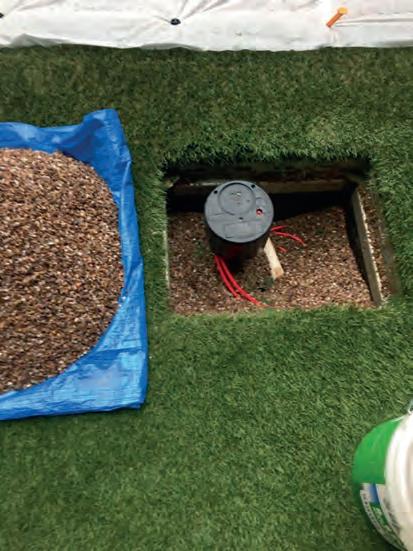
Correct pressure setting for nozzle coverage
Clean out selector switch for ease of use and to prevent rounding off when using the flag key
Check all selector switches are in auto position for automated use of the system. If in ‘off position’, then the sprinkler won’t water electrically from the controller
Are all perimeter sprinklers level to achieve correct curtain?
4. Sprinkler riser
Check and reset arc of the sprinkler
Check for damage and leaks when running
5. Solenoid valves
Have they pressure regulators fitted and if so, are the pressures correct for your system?
Is the flow stem set up correctly so the in-pitch sprinklers retract quickly from ‘turn off’?

Are the in pitch sprinklers leaking? Debris could be preventing the solenoid valve from shutting off fully, therefore weeping at the sprinkler head
6. Turf cups or astro turf tops
Make sure they are secure
Check mesh in the top of turf cup and replace if removed to help roots bind and hold when popping up whilst watering


Check all information in the controller is correct for efficient watering
When the system is running, one of the best methods to check coverage patterns is to use a drone
In the next issue, I ask Pete’s advice on conducting your own Autumn/Winter system audit, which could save you a great deal of heartache, not to mention the cost savings you will reap as a reward for your efforts!
As we all know, it’s always a pleasure to catch up with friends and I thank Pete for sharing with us his knowledge and experience in what can be such a vital, but often overlooked element to turf management.
Article by Phil Helmn.

















Conservation Greenkeeper at Woodhall Spa Golf Club, Stephen Thompson, explains the myths and mysteries of bats.
Bats play a vital role in maintaining the balance of ecosystems worldwide. Their unique adaptations, diverse diets and complex social structures make them one of the most fascinating mammals. As we continue to learn more about bats and work towards their conservation, we can ensure that these nighttime navigators remain integral to our natural world. They bear no relation to birds and are flying mammals belonging to the scientific order
Chiroptera. There are many myths and old tales about bats - some say they are good or bad omens, and others claim they get caught in your hair. I can debunk that myth: bats are highly skilled at navigation using echolocation and actively avoid obstacles. Of course, they are often portrayed as vampire bats in films.
To learn more about the stories behind bats visit www.earthlife.net/bats-in-mythologyfolklore-superstition

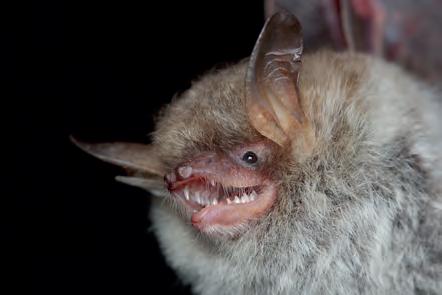

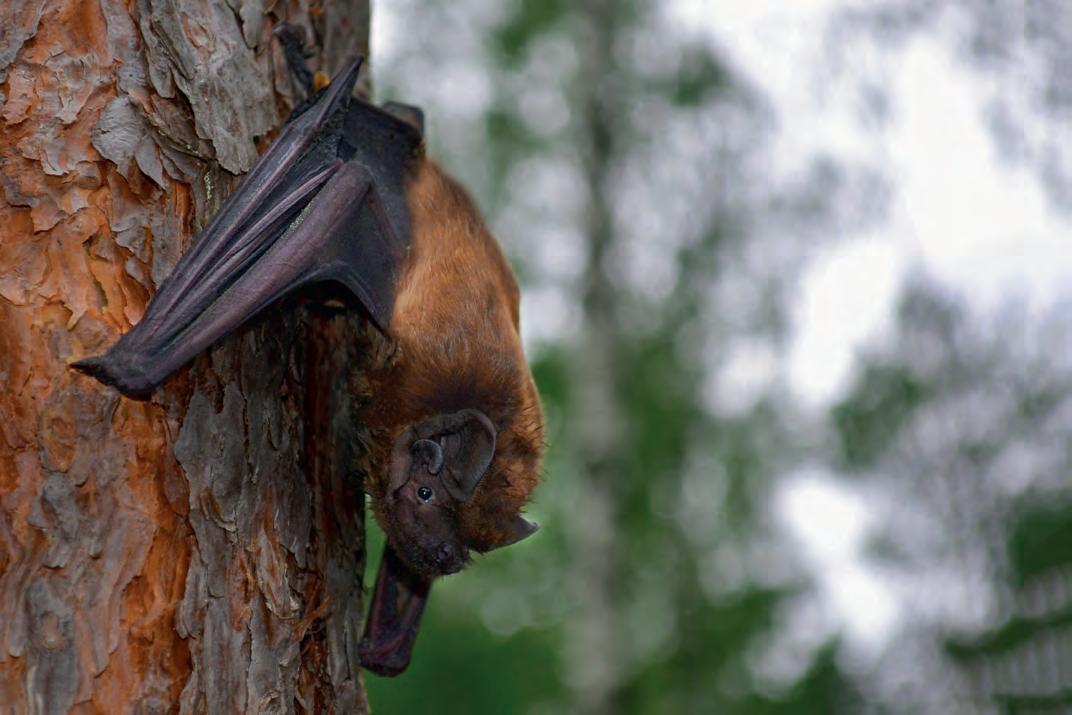
Greater Mouse-eared Bat is no longer considered a resident, with the last remaining male still present in Sussex since the early 2000s. One female was seen in the same area in 2023, possibly a migrant from France.
For more information visit www.bats.org.uk/about-bats/what-are-bats/ uk-bats/greater-mouse-eared-bat
Contrary to what horror films suggest, their diet in the UK mainly consists of insects, including moths. I often spot bats while out mothing in the summer months. Globally, their diet varies and can include pollen, nectar, fruit, fish and frogs. They also function as pollinators in some countries. In Mexico, for example, bats are the only animal that can pollinate the Blue Agave plant - the main ingredient of tequila.
For more information visit www.batcon.org/batsandagave
Nectar vs. pollen:
• Pollen is a fine powder containing male reproductive cells.
• Nectar is a sweet, sugary substance that attracts pollinating insects, which then carry pollen from plant to plant.
Why are bats important for your course?
Golf courses in the UK provide a wide range of habitats for various species and can be particularly attractive to bats. Ponds, other water features, wildflower areas, and roosting spots such as trees and buildings all contribute to a healthy bat environment. Bats are excellent indicators of biodiversity and offer a unique opportunity for conservation on-site.
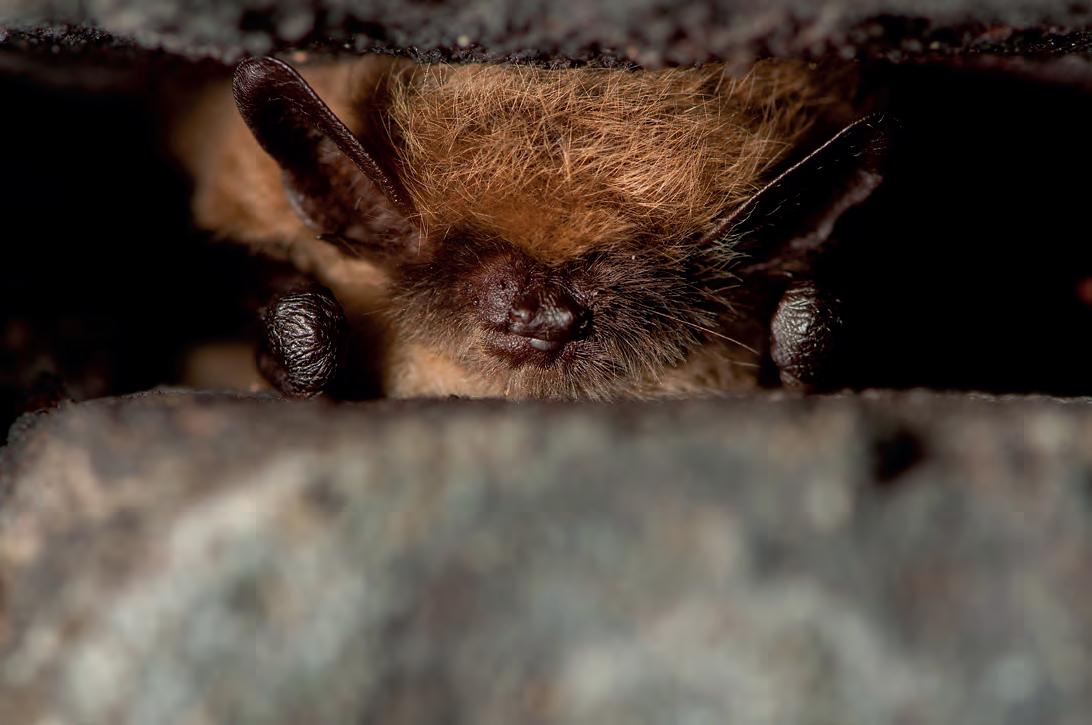
bat groups for surveys and more information. www.bats.org.uk
Your local Wildlife Trust can also assist with surveys and offer information on local bat activity. Some nature reserves run bat walks in the summer, which you can join to learn more.
Peak bat-watching time is during summer months when bats begin to emerge from their roosts around dusk. Identifying species by sight can be tricky, but a bat detector can help. These devices convert high-frequency bat calls into audible sounds, usually a series of clicks.
When I worked at John O’Gaunt Golf Club in Bedfordshire, I ran bat walks with the help of local experts who provided equipment. On several occasions at the Carthagena Course, we detected Serotine bats, which are typically found in the south of the UK. One night, two licensed bat recorders set up mist nets in the area where bats had been spotted. Their goal was to catch and tag one of them electronically (you must be licensed to handle bats).
We succeeded in tagging a Serotine bat, which led us to a roost - the first maternity Serotine roost recorded in Bedfordshire. A great result, and it all started by observing bats on a golf course.

few bat walks first to see which models people are using.
Shop RSPB bat detectors: www.shopping.rspb.org.uk/wildlife-friendly-
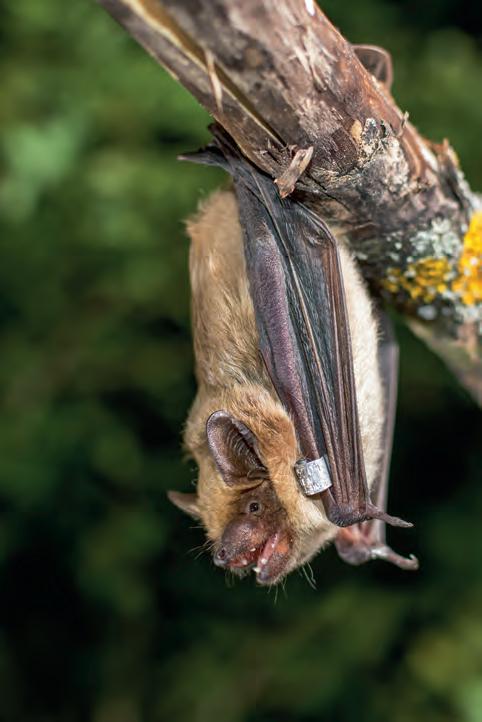
If you can this summer, head out to your local park, golf course, or even your garden, grab a bat detector and start exploring. You might be surprised by what’s out there.

Bluebell: Hyacinthoides non-scripta
In April and May, our ancient woodlands are awash with the much-loved, nodding heads of the Bluebell. Millions of bulbs can exist in just one wood, giving rise to the ‘blue carpets’ that are a springtime joy.
Bluebells are charming, bell-shaped flowers that bloom in spring, carpeting woodlands and meadows with a sea of violet-blue. They belong primarily to the Hyacinthoides genus, with the most well-known species being the English bluebell (Hyacinthoides non-scripta). These flowers are native to Western Europe and are particularly iconic in the British countryside, where they often signal the start of warmer weather.
Bluebells prefer shaded, ancient woodland environments and grow best in moist, well-drained soil.

for longer

A fully automatic relief spin grinder, designed to deliver precision grinding at its best.
It features automatic traverse, indexing and in-feed ensuring that every grind is accurate and consistent, returning cylinders and bottom blades back to the original manufacturers specification. The cast bed provides stability and the heavy duty linear bed rails ensure smooth and accurate traverse of the grinding wheel.


























be set to operate independently



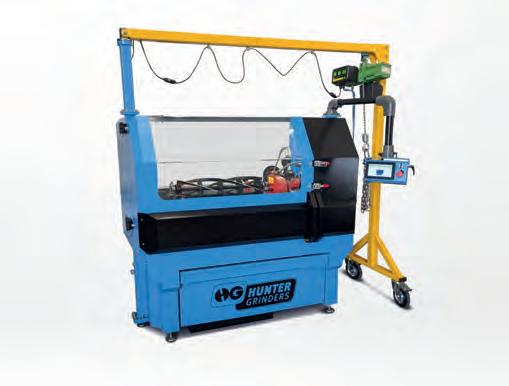









































So states Ribblesdale School in promoting sporting life at The Pavilion, which features the first synthetic pitch of its kind in the UK and one of only five in the world.
The Edel Athmos surface sits centrally between the school’s primary and secondary sites in the Forest of Bowland Area of Outstanding Natural Beauty, overlooked by Pendle Hill, famed for the early 17th century witch trials.
“Our 2G sand-filled surface was twenty years old and suffered from flooding,” recalls Steve Neesham, Ribblesdale’s Site Operations
Manager, “so we needed to improve playing facilities for the pupils. A survey of the old pitch showed blockage of the drainage system by sand.”
An Eco-School Green Flag Award winner, the school is adept at attracting and deploying funding to fuel its drive to sustainability, having already invested £0.75m in its beautifully refurbished and remodelled secondary school library and having bid to open the town’s
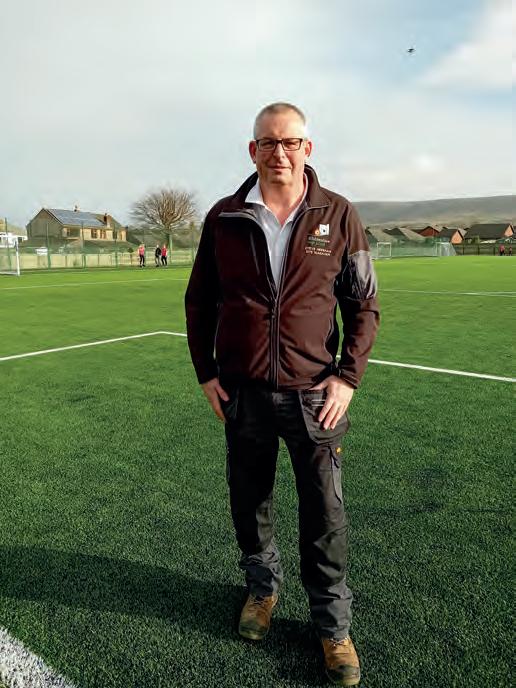

new £10m modular primary school building, complete with its net zero capability design spanning ground source heat pumps and solar panelling. “We’re awaiting our energy certification for the building, which should make positive reading,” Steve adds.
The Pavilion is another step in Ribblesdale’s mission, which as headteacher Anne-Marie Horrocks states, revolves around “only investing in the best”.
Founded in 1932, Ribblesdale is the educational hub offering rounded development for well over 1,300 secondary and nearly fifty primary pupils, including a diverse sporting and enrichment programme offering everything from golf and go-karting to BMX biking ànd eSports “to test pupils’ limits and expand their sporting and wider educational experience well beyond the National Curriculum and our school boundaries”.
A natural grass football pitch, running track and MUGA serve the primary site while the secondary site benefits from a sports hall, three MUGAs and multi-use activity studio, opened in 2021.
With natural grass pitches, a brand new 3G and a range of MUGAs on offer, the school enjoys links with local football, tennis, cricket and rugby clubs. Plans are underway to open up the school’s facilities for further community use.
Left Ribblesdale’s Site Operations Manager Steve Neesham.
Over recent years, more than 1,000 homes have been unveiled in Clitheroe, which the school expects will spark heightened demand for the 3G facility which, installed by Blakedown Sport & Play, features foldaway goalposts, enhanced perimeter fencing, ride-on compact tractor and drag brush.

“Our new pitch is used during and after the school day for sports lessons and inter-school matches and is attracting plenty of interest from local and regional football clubs,”
Anne-Marie explains.
“We already enjoy football success, with our Year 7 team reaching the English Schools Football Association’s (ESFA) cup final this year, due to be played at West Bromwich Albion’s ground next month.”
Fitting for Ribblesdale’s innovative thinking, the school runs its own Eco Group, whose pupil members are all eyeing its green credentials avidly. “The group is fiercely anti-plastic,” Anne-Marie says, “and champions growing and recycling our food (an apple orchard yields crops for food technology lessons and charity baking events every year) as well as planting flowers to attract pollinators.”
No doubt the group had its say about how sustainable the new pitch should be. In the end, Ribblesdale settled on the best possible available solution – a surface that can be fully recycled when the time comes to replace it.
“The dual fibre has a recycled interior and a virgin material exterior that can be

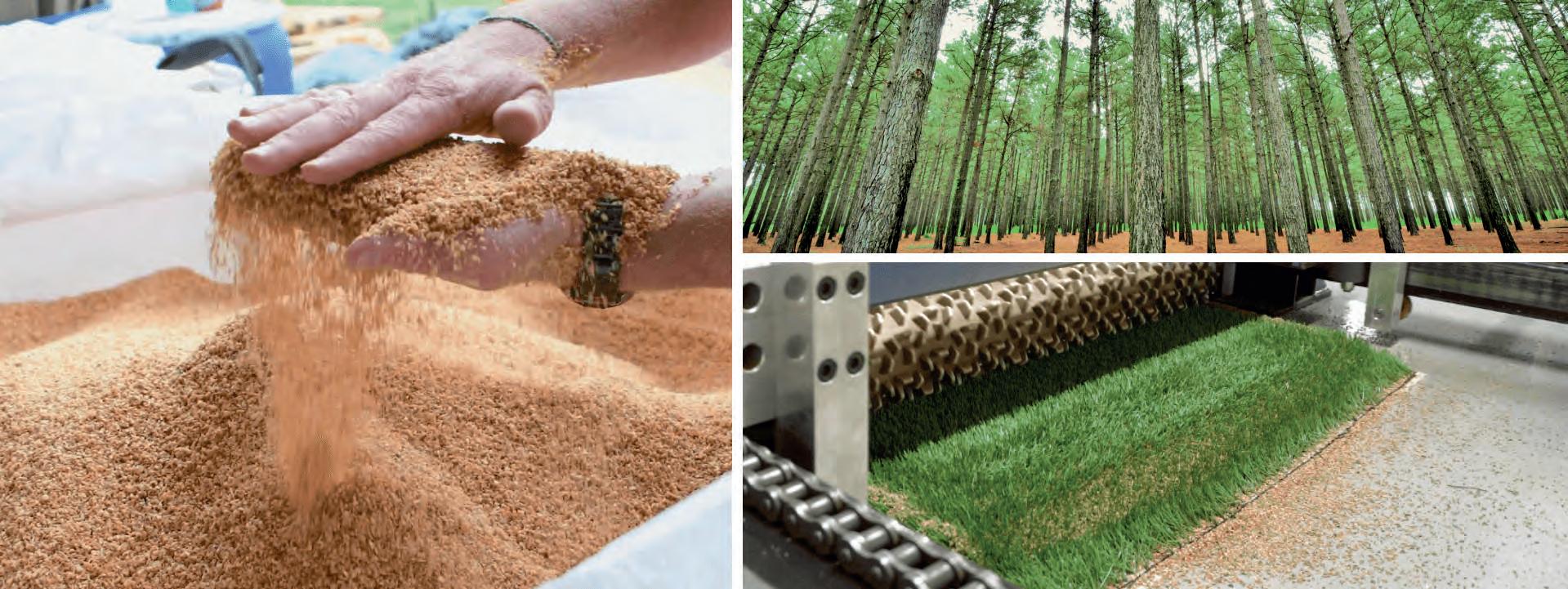
repurposed,” Steve explains. Choice of infill was the subject of long debate. “SBR (styrene butadiene rubber) was our final choice. It has a 12-year lifespan.”
“Other infills were still being tested. The pitch
has perimeter grills and brushes to help prevent the crumb spreading beyond the playing surface. Blakedown were very helpful, listening carefully to our requirements, and generous with their time – returning several times before the project went ahead, with the backing of a 50,000 Euro grant, which they sourced for us.”
Over its lifetime, the surface can be used 1,500 hours on average, Blakedown says, and the school is hoping run a sinking fund to invest in a replacement surface under its medium-term planning.
There’s scope for parking at the new pitch, in time, and other plans are afoot, Steve says. “We’ll seek funding for a 20-space area, and we plan to link the primary and secondary sites to facilitate more parking and so futureproof the facilities for pupil numbers and community use.”
Pitchcare spoke to Blakedown Sport & Play director Avi Natan about the new surface.
“Manufactured by EdelGrass in The Netherlands and called Athmos, the surface is made from the same polymer family, to simplify the end-of-life recycling,” he explained.
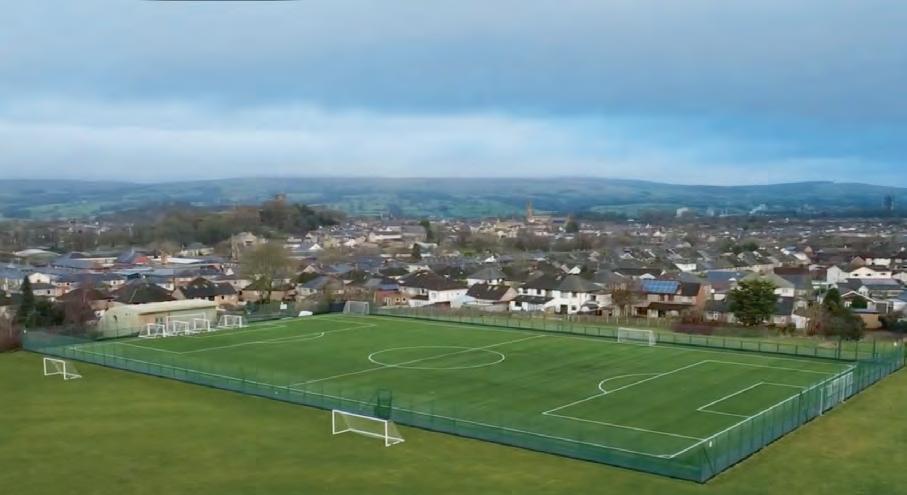
“The central spine of the carpet fibre is made using recycled materials, encapsulated within virgin polymers to provide strength and colour evenness. The surface has a 50% recycled content when manufactured.”
Production of the yarn reduces environmental costs by 43%, he added, while the shockpad can be lifted and reused in other facilities at the end of the carpet’s lifecycle.
“Infills for the carpet are either natural silica sand, which can be cleaned and reused in future sports pitches or in construction, or recycled SBR from end-of-life tyres, which can be cleaned and reused for future pitches.”
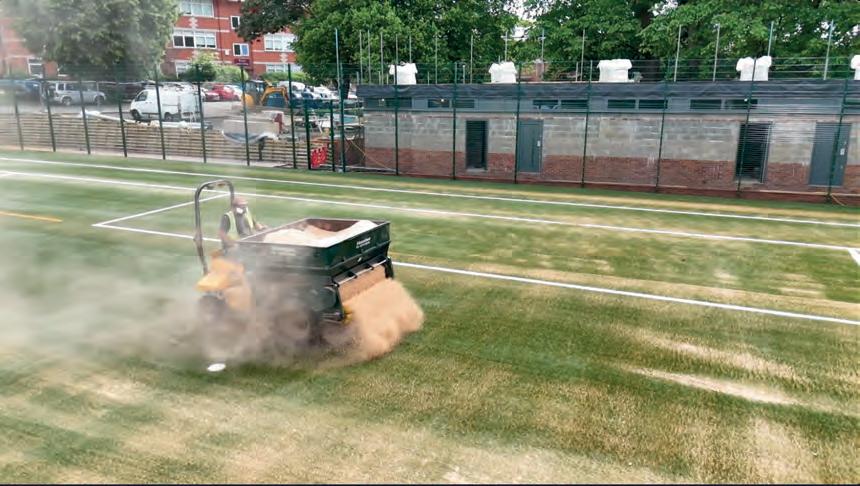


Another synthetic turf innovation has been completed, this time in the south, where Blakedown Sport & Play has installed a 3G pitch at Cardinal Newman School in Hove, West Sussex.
The biodegradable infill is US-made BrockFill – fashioned from a species of southern pine, “grown, harvested and replanted in continuous cycles”, producer Brock states.
The infill fosters playability that feels like natural turf and falls within the optimal traction range, says pitch manufacturer Condor Grass, whose surface Cardinal Newman School now runs.
Cardinal Newman School is a large mixed comprehensive for 11 to 18-year olds – the largest Catholic school in England with 2,500 pupils –and is celebrating completion of a pioneering project that’s had a long gestation but has placed
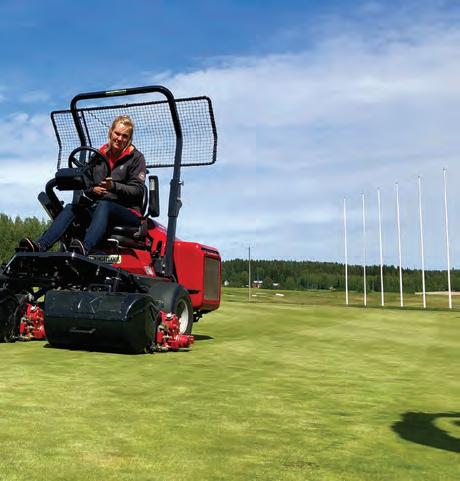



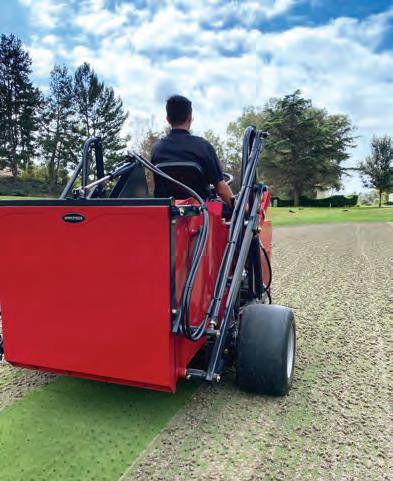




the former French nunnery and convent at the forefront of sporting provision.
Its three natural grass pitches were already heavily used, reports premises manager Darrin Halsey, who also handles groundcare. “We run rugby, football, athletics and cricket on the grass surfaces, as well as tennis on two Tarmac

and two artificial turf courts, and netball,” he says, “and were thinking before Covid about transforming our front grass pitch to artificial to meet large demand from both the school and local community.”
“The first workings began in September 2023 with Blakedown levelling the inclined pitch, taking away the turf and repurposing fifty truckloads of topsoil for other projects.”
Since the pitch came on stream in February, the ride-on tractor and drag brush are used daily by Darrin’s team of three to ensure the infill is level across the surface, particularly in the goalmouths, to ready it for football and rugby.
They’ll also be kept busy leaf blowing come autumn from the wooded area running parallel with the pitch. “The surface is a delight now spring has come, taking only one and a half hours to brush the whole area. The drainage is working really well too,” Darrin says.
One of the first in Britain, the infill is billed as ‘durable, cool and affordable’, delivering ‘best performance’ and ‘engineered for athletes’, while ‘smooth rounded particles’ are precisely sized to facilitate optimal drainage and provide the natural foot traction demanded by athletes.
A major concern for Brock is creating ‘urban heat islands’ with synthetic turf infilled with rubber crumb. In stressing the importance of synthetic turf surface temperatures, Brock explains: “A typical athletic field is equivalent to a 500 car park spaces and can reach more than 80oC.”
“Our findings (using drones for thermal imaging to compare surface temperatures, rubber crumb infill, natural grass, organic infill and urban structures such as car parks) reveal that rubber crumb fields can surpass even asphalt in heat absorption.”
Following Brock’s nine-step manufacturing process, it tested the infill on a synthetic pitch next to a rubber crumb filled one of the same turf, on the same day, time and when both were dry. The BrockFill pitch was 19oC cooler than the rubber crumb test area, which also included cooling agent, the manufacturer found.
Its low thermal conductivity reduces heat transmission through shoes and skin, Brock reports, adding: “The difference is even great after rain. A cooler surface can reduce surface dehydration to reduce injury risk,” and the surface is even better when damp, it claims, also “achieving the lowest splash when dry compared to other infills.”
Article
by Greg Rhodes.
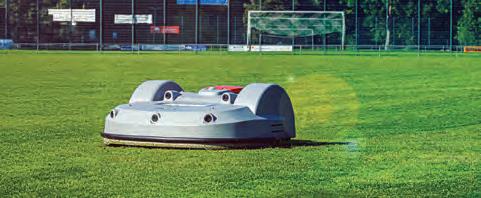



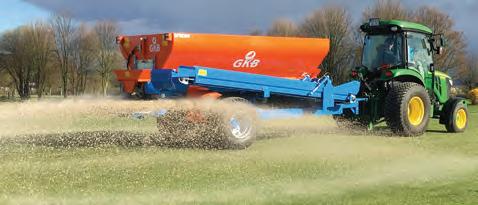
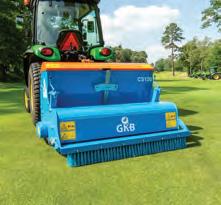



Simon Barnaby, ICL Business Development and Key Account Manager –Stadia, outlines some of the key summer disease threats, the environmental triggers to watch for, and how to build a robust and practical response.
Having worked across tournaments and stadia throughout Europe, I’ve seen first-hand how quickly summer turf diseases such as Pythium blight, Grey leaf spot, Brown patch and various other Leaf spots can compromise surface conditions. I’ve seen them take hold rapidly, wiping out areas of newly sown
ryegrass in conditions that seemed entirely manageable the day before. These diseases can infect the turf surface incredibly fast - and can be unforgiving.
Now, in my role, I’m supporting venues - not just with product advice, but by helping grounds teams interpret conditions, plan disease management strategies and strengthen decision-making.
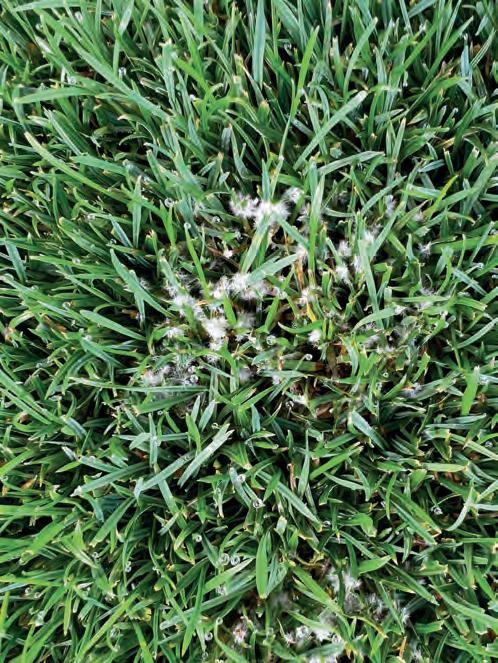

inputs and frequent irrigation, increasing disease susceptibility.
• Zero tolerance for damage: Unlike golf greens where some damage might be tolerated, stadium and training ground pitches demand immaculate playing surfaces all season, meaning even minor disease outbreaks can have serious consequences.
• Microclimates in stadia: Enclosed or semi-enclosed stadium environments can trap humidity and restrict air movement, fostering conditions that favour pathogen development.
• Increased foot traffic and wear: The return of pre-season training and friendly fixtures in July and August adds additional plant stress, further weakening the turf’s natural defences.
A proactive approach is crucial. Understanding the conditions that drive disease outbreaks, and recognising early symptoms, allows for timely cultural and chemical interventions. Here, we explore four of the most common summer turf diseases and how to manage them.
(PYTHIUM
patches often appear overnight.
• Rapid turf collapse: Entire patches can wilt and die within 24–48 hours.
• Fluffy mycelium: Cottony white growth may be visible in the early morning under humid conditions.
Management strategies
• Reduce leaf wetness: Water deeply but infrequently, avoid evening irrigation and improve drainage. Use an appropriate wetting agent to drive moisture into the rootzone and avoid excess surface wetness.
• Increase airflow: Consider removing or thinning tree lines around training pitches and consider fans in enclosed stadia.
• Clean machinery and footwear: Use appropriate disinfectants on equipment and for staff and players.
Fungicide protection*
o Preventative: Apply Heritage (azoxystrobin) ahead of prolonged warm and humid periods.
o Curative: Apply FR321 (azoxystrobin + fludioxonil + Ryder). Act immediately at first symptoms - Pythium spreads rapidly via water.

Conditions to watch out for
• Warm, humid weather: Prolonged daytime temperatures above 25°C and night-time temperatures above 20°C with high moisture.
• Juvenile ryegrass: Particularly aggressive on newly sown turf.
• Nitrogen-driven growth: Excess nitrogen creates tender, susceptible tissue.
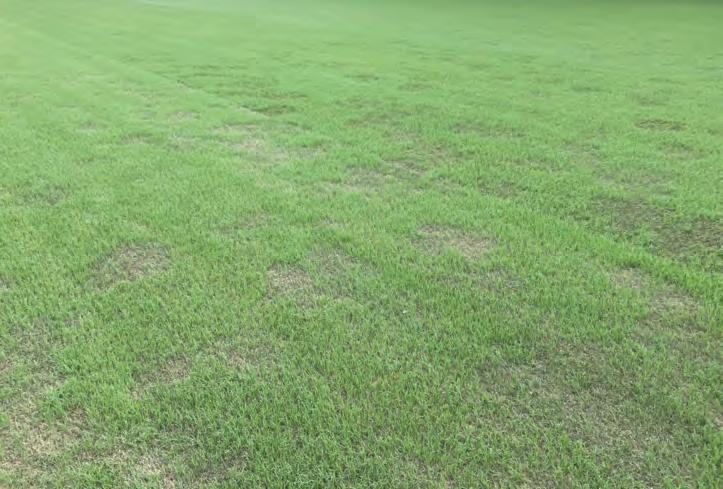
How to identify Grey leaf spot
• Small, water-soaked lesions: Appear greyish on leaf blades.
• Twisting and wilting: Leaves curl, twist and collapse, thinning the turf.
• Greyish, velvety spores: Outbreaks may result in a spore mass on the surface.
• Larger areas appear dry and shrivelled. Management strategies
• Nitrogen management: Avoid excessive applications of immediately available nitrogen. Use slow release and controlledrelease fertilisers.
• Cultural practices: Increase airflow (using fans in stadiums), reduce organic matter accumulation, and avoid excess surface moisture.
• Irrigation management: Water deeply and less frequently using a wetting agent like Qualibra. Avoid evening irrigation and prolonged leaf wetness.
• Use resistant cultivars: Choose cultivars with known resistance to GLS.
• Clean/disinfect machinery and footwear. Fungicide protection*
o Preventative: Ascernity (difenoconazole + Solatenol) or Instrata Elite (difenoconazole and fludioxonil) in high-risk conditions.
o Curative: Use Medallion TL (fludioxonil) for contact action during severe outbreaks.

Conditions to watch out for
• Consistent mild temperatures.
• Prolonged damp surface conditions.
• Overfeeding with nitrogen (soft, succulent growth).
• Nutrient deficiencies.
• Overwatering.
• Close mowing.
• Surface compaction.
• Shade and poor air movement.
How to Identify Leaf spot
• Three main pathogens: Bipolaris spp. (more common in summer), with Curvularia spp. and Drechslera spp. also present, particularly on seedlings.
• Small dark yellow, brown or black lesions on leaf blades, progressing to larger spots with dark margins and leaf dieback.
Management strategies
• Reduce surface compaction.
• Balanced nutrition to avoid deficiencies.
• Sharp mower blades.
• Avoid excess irrigation.
Fungicide protection*
o Preventative: Ascernity (difenoconazole + SOLATENOL) or Instrata Elite (difenoconazole + fludioxonil).
o Curative: Medallion TL (fludioxonil) in case of outbreaks.
Conditions to watch out for arm, moist conditions: Especially when nighttime temperatures stay above 17°C.
ush turf and excess organic matter: Risk increases with over-fertilisation, overwatering and organic matter buildup.
How to identify Brown Patch
cular, brown patches: 10 cm to 1 m wide, sometimes with smoky rings.
Morning mycelium: Brown mycelium visible on dewy mornings.
eaf lesions: Irregular tan lesions with dark borders. Management strategies
• Water management: Irrigate in the early morning and avoid excess water.
• Organic matter control (if not a full renovation): Aerate and top dress with an appropriate sand to reduce thatch build up and improve drainage.
Fungicide protection*
o Preventative: Ascernity (difenoconazole + SOLATENOL) or Heritage (azoxystrobin).
o Curative: Instrata Elite (difenoconazole + fludioxonil) or Medallion TL (fludioxonil) when symptoms appear.
Leaf spot diseases are common in intensively managed sports turf, especially where stress, compaction and disease pressure coincide.
Each site has its own microclimate, renovation pressures and performance expectations. But across all venues, the key elements of disease prevention remain consistent:
• Observation: Monitor surface moisture, canopy density and weather conditions.
• Early identification and action: React quickly at the first signs.
• Cultural control: Improve airflow, manage thatch and avoid excess nitrogen.
• Planned fungicide use: Rotate actives, apply in line with conditions and act before issues escalate.
Managing disease through the summer doesn’t need to be a firefight. With the right foundations and a clear plan, it becomes just another part of good surface management.
*PLEASE NOTE-ThisarticleincludesdiseasemanagementstrategiesfromICL’s portfolio.Alternativesolutionsandstrategiesareavailable.Alwaysreadthelabel.

As vandalism increases across the industry, Pitchcare spoke to Head Greenkeeper David Byron, who reflected on the extensive work caused by just 60 seconds of vandalism at Thorndon Park Golf Club.
As a greenkeeper, one of the most frustrating things is unnecessary damage. David shares how the club aims to restore the playing surface. How much damage was caused?
It was the first time Thorndon had experienced damage on this scale. At the time of the vandalism, David was away in Harrogate for BTME. He recalled: “It happened on the 19th of January. The pro called me about some damage on the 16th green; at that point, we
thought it was limited to that green. The next morning, I received a call at 6:30 am from my first assistant, Sam, who told me the damage was widespread. We had to conduct a damage assessment to determine the extent.”
When the report came in, David was shocked: “It revealed damage to six greens, four tees and a couple of fairways. It was heartbreaking. At this time of year, it couldn’t have come at a worse time.”

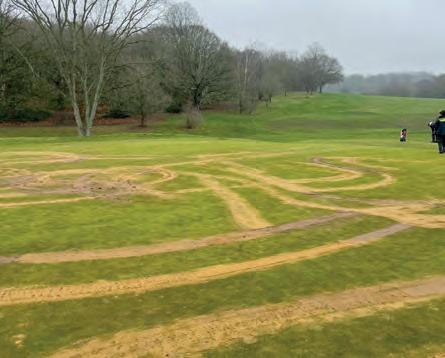
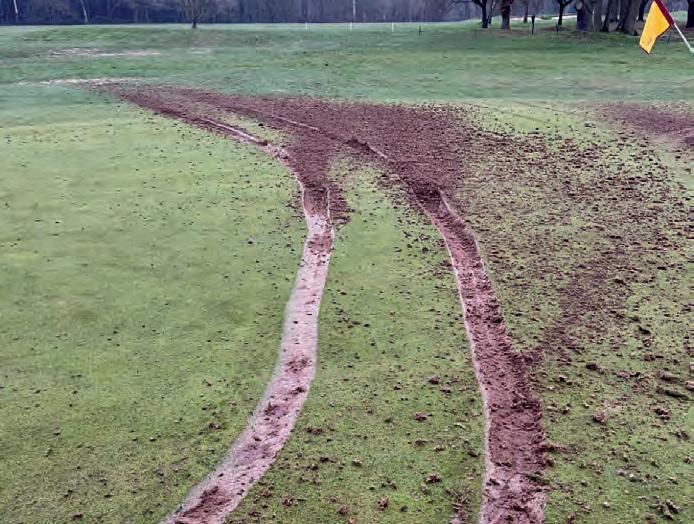
“Initially, we considered borrowing turf from one of the better greens to repair the others. The 15th green was a candidate, as it needed work, allowing us to address two issues at once. However, there was reluctance to tear up an undamaged green.”
“An emergency greens meeting was held and we agreed to use the putting green. We could afford to close it for a season if it meant restoring the main greens by June. The deeper areas received the new turf, while the less damaged spots were top-dressed.”
“Had this happened in June, we could have cored, topdressed and allowed it to grow back. But in January, with frozen and rain-soaked ground, we knew the deeper damage wouldn’t recover for months.”
“With the course being clay-based and the poor weather conditions, transporting the turf from the putting area to the damaged greens has been difficult. At times, it feels like we’re causing damage while trying to repair it.”
It’s about keeping everyone motivated and getting the course back to where it should be!
The day after the vandalism, members came out in force to help the greens staff clear debris which allowed David to properly assess the damage. He also highlighted the importance of insurance: “We spoke to the insurance company, and because of our chosen repair approach, we saved them a significant amount of money. They expected a much higher claim due to the social media coverage. As a result, they agreed to cover other projects we had to delay due to the repair work, allowing us to bring in contractors to help.”
With vandalism becoming more common across the industry, David recognises that Thorndon Park is fortunate: “We’re lucky to have a club that supports us. We have the tools, staff and members who are willing to help - whether it’s raking bunkers or picking up debris during the repairs.”
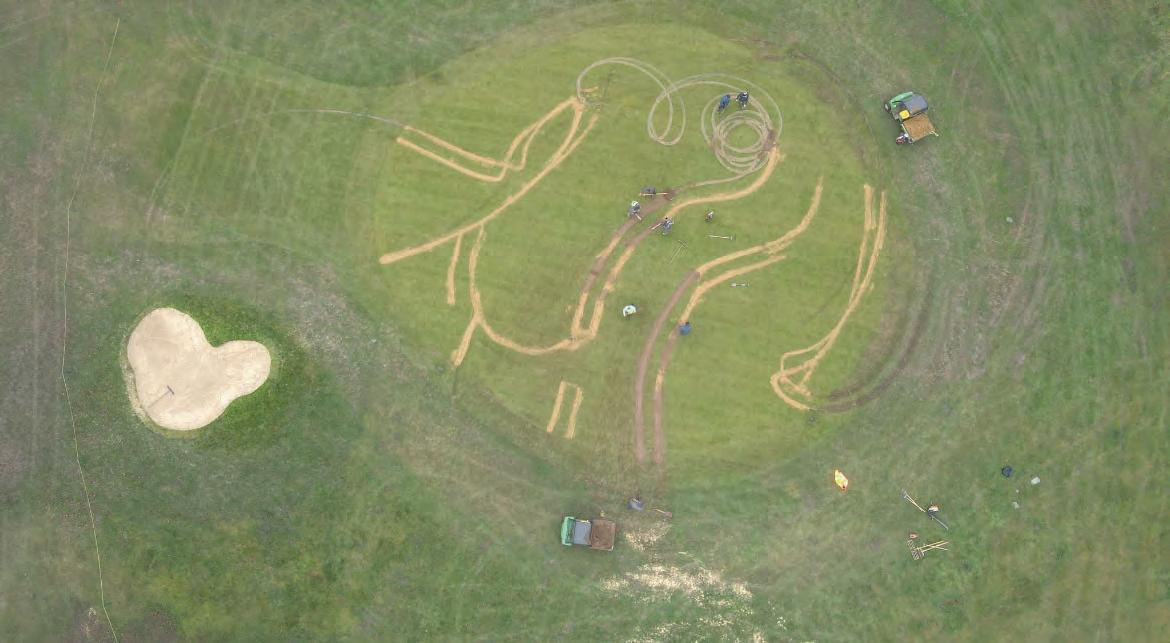
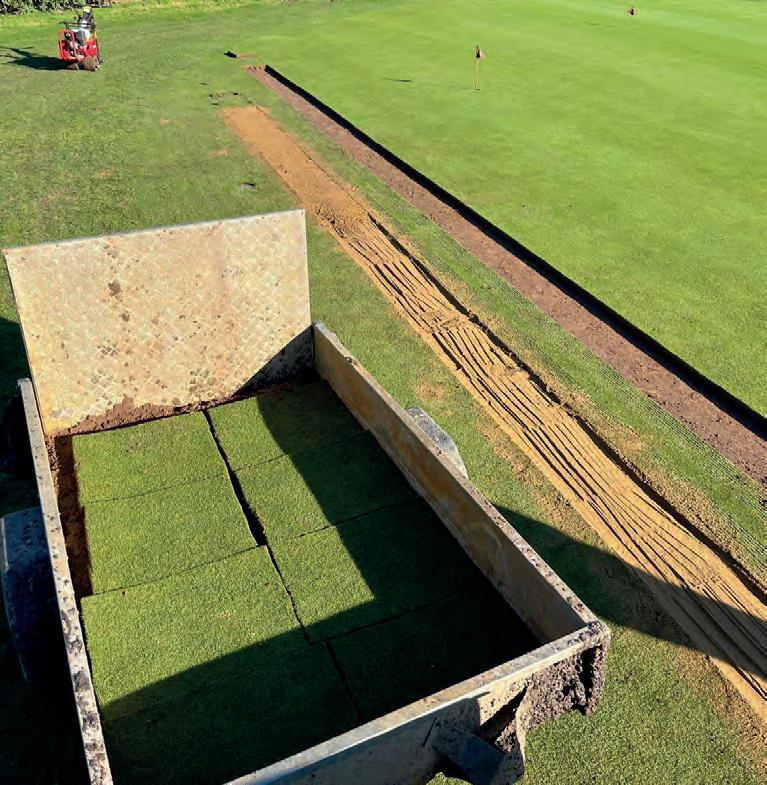
“Other courses have offered us greenkeepers to help with the turfing and some have even provided our members with complimentary rounds. This difficult situation has really highlighted the goodwill within golf.”
Although the police arrived on the day of the incident, little action was taken. “It feels like they aren’t that interested in vandalism,” David said. “I think that’s due to a lack of understanding about the effort that goes into maintaining a golf course and lack of resources on their side. For a club with a smaller budget than ours, this kind of damage could be devastating.”


Mental resilience
Beyond the physical damage, vandalism also takes a mental toll on those responsible for maintaining the course. David takes a positive approach: “It’s easy to feel defeated and bury your head in the sand. Don’t get me wrong - when I first saw the images, I wanted to cry. When I returned to the course that Wednesday, I had the same feeling. But that quickly turned into determination to restore the course. We made a lot of phone calls and put a repair plan in motion.”
“All I wanted to do was get back and see the extent of the damage, but realistically, there was nothing I could have done in those first few days.” However, he found comfort in the support from fellow greenkeepers at BTME: “Many had seen the social media posts and their backing meant a lot. It made me feel better about the situation.”
David also acknowledged the impact on his staff: “They were all disappointed. It’s the winter blues as well - they’ve just finished three months of leaf blowing, thinking about upcoming projects, only to have everything set back by the repairs. Morale is lower than I’d like, but they’re pushing through.”
Despite the challenges, David remains focused on recovery: “It’s about keeping everyone motivated and getting the course back to where it should be. We’ll get through it.”

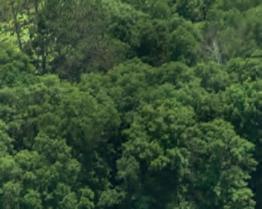

LIVING LANDSCAPES:
SPORTS. LANDSCAPES. ENVIRONMENT.
Article by David Chammings
The Asian hornet (Vespa velutina), also known as the ‘Yellow-legged Hornet,’ is an invasive species that poses a significant risk to outdoor workers in the UK.
First detected in the UK in 2016, this species has been increasing in numbers, raising concerns for those working in agriculture, forestry, construction and other outdoor environments. These hornets are aggressive when disturbed, and their venomous sting can cause severe allergic reactions. Furthermore, their presence threatens native pollinators, particularly honeybees.
This article explores the dangers of Asian hornets, signs to watch for, and essential safety advice for outdoor workers.
Dangers of Asian hornets to outdoor workers
1. Aggressive nature and stings
Asian hornets are particularly defensive around their nests and may attack in swarms if they feel threatened. Their sting is extremely painful and more potent than that of a wasp or honeybee. For individuals with severe allergies, a sting can trigger anaphylactic shock, requiring immediate medical attention.
2. Risk to work environments
Workers in forestry, farming, gardening and construction face an increased risk of encountering Asian hornets due to their tendency to build nests in trees, hedges,
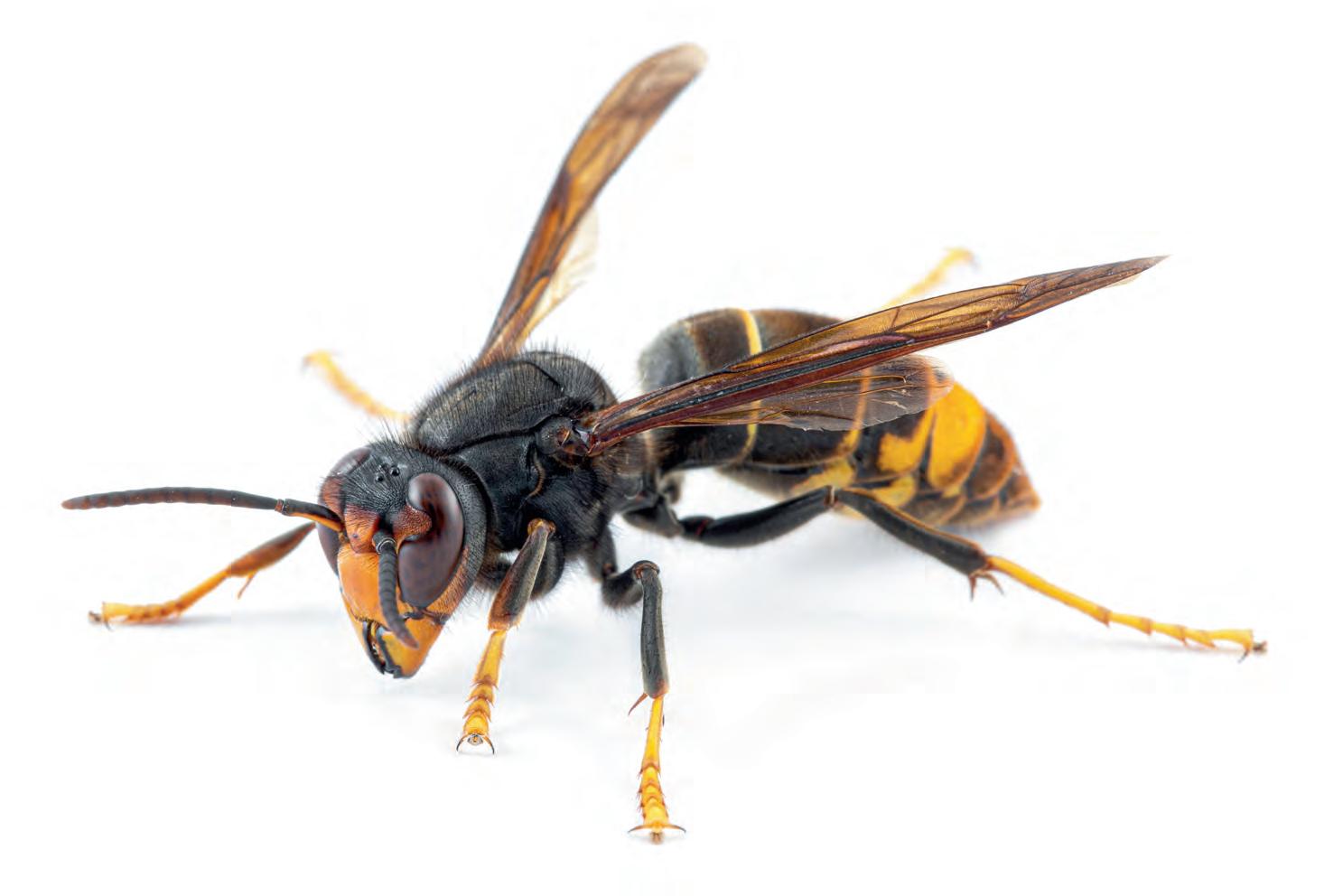

sheds, barns, and even underground cavities. Disturbing a nest accidentally while working can provoke an aggressive response.
3. Impact on local ecosystems
Asian hornets are a major threat to bees and other pollinators, which can have knock-on effects for agriculture, as reduced pollination impacts crop yields. Beekeepers and farm workers should be especially vigilant.
How to identify an Asian hornet
Asian hornets can be distinguished from native hornets and wasps by their:
• Size: Adults are around 3 cm in length, with queens reaching up to 3.5 cm.
• Colouration: Black body with a distinctive orange-yellow face and yellow-tipped legs.
• Nest Location: Large paper nests often found in hedges, trees, buildings or underground.
Safety advice for outdoor workers
1. Avoid disturbing nests
If you spot an Asian hornet nest, do not approach or attempt to remove it yourself. Keep a safe distance and report it to the appropriate authorities.


2. Wear protective clothing
Workers at risk should wear long-sleeved clothing, gloves and, if necessary, protective face coverings when working near potential nest sites.
3. Be prepared for stings
• Carry antihistamines if you are prone to allergic reactions.
• If stung, move away quickly to avoid further attacks.
• In case of severe allergic reactions (difficulty breathing, swelling of the throat), seek emergency medical help immediately.
4. Use caution with food and drinks
Asian hornets are attracted to sugary substances, so keep food and drink covered when working outdoors.
Facts about Asian hornets
• Beekeepers wear 2-3 protective suits when dealing with Asian hornets, as they have 6 mm stings.
• Asian hornets can wipe out all native honeybees in 15 hives within two weeks.
• Asian hornets can fly at speeds of up to 40 km/h.

Remember…
Asian hornets present a growing risk to outdoor workers in the UK. By recognising their appearance, avoiding nests, wearing protective gear and reporting sightings, outdoor workers can stay safe while helping to protect the UK’s ecosystem from this invasive threat.
Stay vigilant and report sightings to protect yourself, your colleagues, and the environment.
If you suspect the presence of an Asian hornet, report it immediately:
• Asian hornet watch app – Available on iOS and Android for quick identification and reporting.
• Email – Send sightings to alertnonnative@ceh.ac.uk with photos and location details.
• Online reporting – Use the UK Non-Native Species Secretariat (NNSS) website.
• Local beekeeping associations – Many beekeeping groups work with authorities to track and manage hornet populations.
Prompt reporting is crucial for controlling the spread of this invasive species.



The increasing fluctuations in weather patterns present plenty of challenges for groundspersons in all sports, but on the racecourse the decision to cancel a fixture or press ahead with the day can be an especially complex one.
Depending on the underlying drainage and situation of the course – next to a river, on free draining soils etc – periods of intense rain can threaten the meeting. But even if there is no obvious waterlogging, ‘false ground’ can cause an abandonment as it may risk injury to horses and jockeys.
STRI turf consultant Steve Gingell works closely with a number of racecourses, and he explains: “False ground is an area of deep unstable ground on the running line. It can be obvious if there is no grass cover, in which the grounds team can easily spot the area and address it. However, where there is grass cover,
it only becomes apparent when walking or riding over it. The hoof goes into the ground to depth as there is no support offered by the surface.”
Jason Loosemore, Clerk of the Course at Exeter, comments: “The horse’s hoof will go into false ground deeper than in the previous stride - when they are travelling at 30mph they need consistent footing to be confident when galloping and jumping.”

False ground can lead to horses becoming unbalanced and stumbling, which is why when a patch of it is discovered during a race –usually after a sudden deterioration in weather conditions - it can lead to the abandonment of the remainder of the meeting.
“It’s important to distinguish false ground

from heavy ground,” comments Steve. “This will have resistance which makes it more difficult for the horse to travel through it, but will still offer support.”
He emphasises that it should also not be confused with waterlogged ground.
“Groundsmen will know if a waterlogged course will drain before the track inspection; on tight soils the top may be wet but it will drain through. It can be a tough call, but the aim is always to get the race meeting on.”
In soil terms, ‘false ground’ is a function of the soil being over filled with water, he points out, so the soil loses structure and has no strength.
Where is false ground likely to occur?
Steve identifies dips and low points as the most likely sites for false ground, where water can sit on the surface.
It can be seen on areas that are overtrafficked, such as crossing points and grass canter downs, chutes and loops.
“It’s most common on National Hunt tracks as they get more wear in the winter. False ground tends to affect small areas unless there is a severe flood event.”
Jason agrees, adding: “Areas getting the most wear react differently to rain or irrigation water compared to freer draining parts of the track.”
Spring lines are another common site, Steve says: “Bubbles of water from springs separate out the soil layers so you get a carpet of ground with water lying under it.”
“A rare cause is salinity from salt water which enters the soil after coastal flooding; few courses would be affected by this in the UK.”
Jason adds that large volumes of irrigation water in one place can also have a detrimental effect on consistency – comparing 1/2in of
Above and Below Newton Abbot’s busy summer racing programme means that scarifying is not an option, but keeping thatch to a minimum by harrowing and using a blower when mowing has paid dividends.


The interaction between the horse’s hoof and the racing surface has a significant effect on the result of the race, as the surface needs to support the hoof and give the horse confidence to gallop or jump.
©
Exeter Racecourse/ Francesca Altoft
irrigation water to 4in of rain in an hour.
At Newton Abbott, where racing takes place in the summer months, wet conditions exacerbate spongy ground from thatch, explains Clerk of the Course Ben Robarts.
“It’s inconsistent ground so the horse moves over it in a different way. It was especially problematic after the wet spring in 2024.”
He points out as there are eighteen racedays across the summer at Newton Abbot, it’s not possible to address the thatch by scarifying.
“We vertidrain and slit to get air in and use a harrow to pull thatch out. Fortunately, this year
Deep tining keeps the surface open to sand columns and drainage below and can help with restructuring.
© Fairways Group.
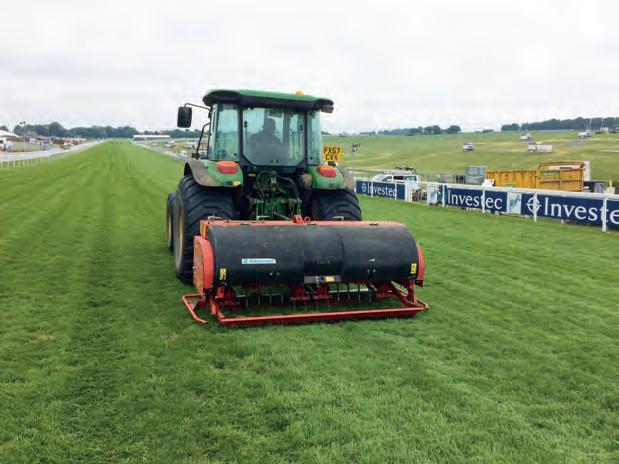
the dry conditions have worked in our favour and there are very few suspect patches on the running line. We’ll avoid watering in these areas, rake and aerate. We’ve also purchased a blower for the mower tractor to minimise the debris going back into the surface.”
Immediate action is to take the area out of use so that the problem can be addressed, and where suspect patches are observed by ground staff during their daily routine, they can be railed off or jumps moved to avoid travelling over them.
“The objective is to return the ground to good grass with a sound rooting structure and, ideally, plenty of worm activity to recreate the structure,” explains Steve. “Decompaction is important and on clay soils, adding gypsum can be helpful.”
More intensive remedial action can be taken


when the racecourse has its closed season.
“It’s obviously important to keep off the ground until conditions improve, but vertidraining through summer can benefit restructuring; we probably still don’t use the vertidrain enough on racecourses.”
Jason comments that a programme of aeration, spiking and sanding, plus the application of grass seed helps to remedy the issue.
Prevention includes assessing the areas at risk and considering how the running lines are affected, Steve adds: “Can the rail be used
to protect vulnerable areas? How often is a particular patch of ground used? Bends tend to get bulk of the attention, but crossings are also at risk.”
Planned renovations can also target these areas, he explains: “The aim is to get the land dry and stable, so installation of sand columns and using the vertidrain to keep the surface open to the drainage is effective, but ensure that conditions are suitable; it can sometimes be several months before you can get onto the worst affected areas.”
“A more robust vertidraining regime is used

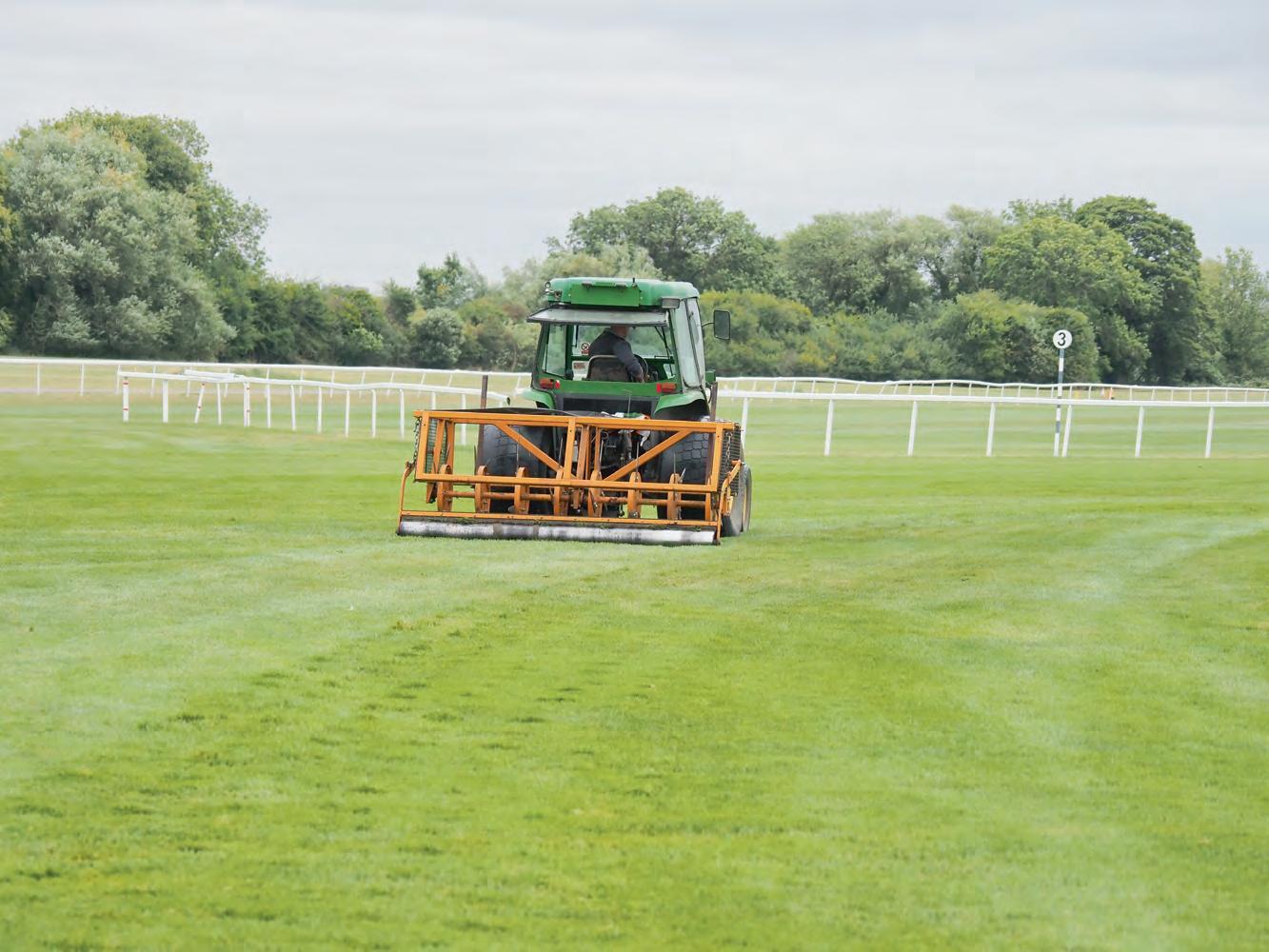
movements are used proactively to protect
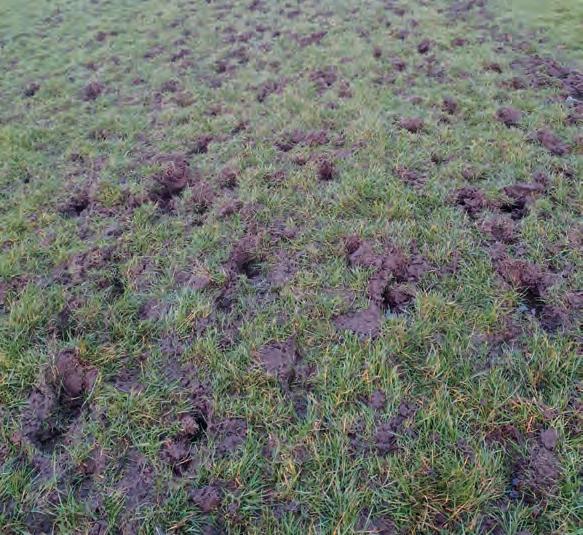

Rail movements are used pro-actively to protect ground from excess wear, he adds, with six ‘man days’ needed to move all the rail as little as 1m. This is a process which takes place for every meeting unless the ground is firm.
Where there is a spring line, it’s worth looking at whether it can be tapped, Steve suggests.
He also recommends that grounds teams also work closely with their agronomist and BHA track inspector to help address problem areas.
Article by Jane Carley.
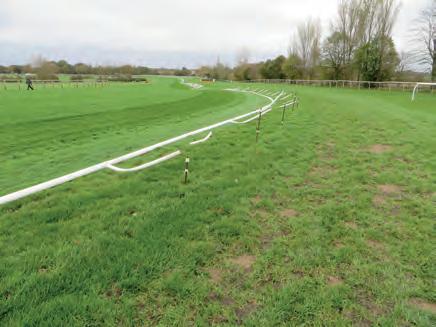



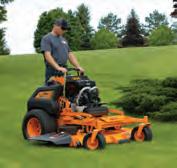

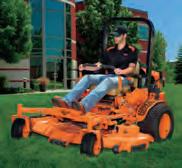
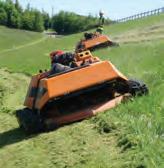


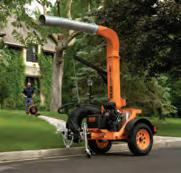






































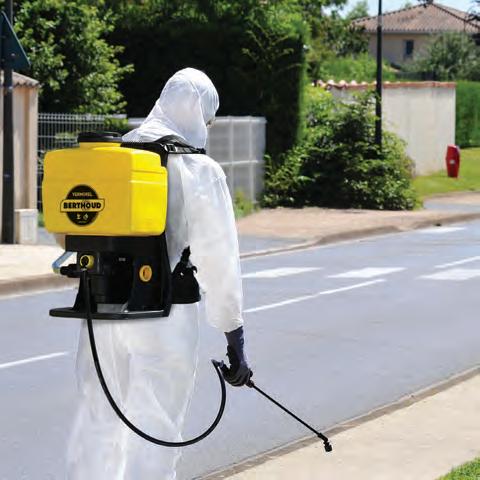
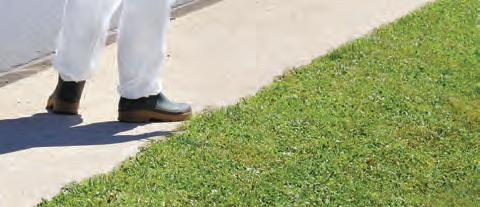
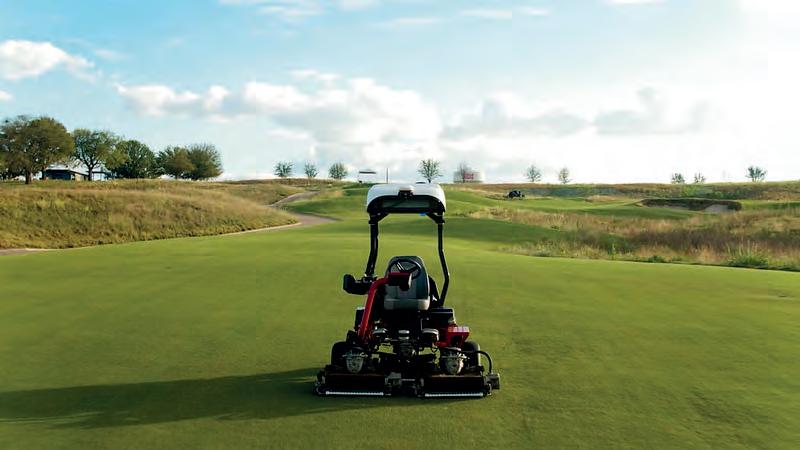

Lee Rowbotham GeoLink and Digital Specialist
There’s a lot of talk about automation in turfcare right now. But what we’re seeing with Toro’s new autonomous range is more than just ‘something new to be excited about’. It represents a genuine shift in how we think about and approach turfcare.
Toro hasn’t simply built machines that can operate without a driver. It has built intelligent, practical tools to help with the most pressing challenges in greenkeeping: widespread labour shortages, rising operational costs, and the growing requirement to do more with less – all without compromising on quality of cut.
As Toro’s new technology begins to roll out across the UK, I’m working closely with our extensive dealer network in my role as GeoLink and Digital Specialist at Reesink Turfcare. My focus is on supporting clubs and turf professionals through the transition to autonomous technology –
helping them understand what these machines can do, how to integrate them into daily operations, and the potential they offer to enhance turf management.
We understand welcoming autonomous technology to your club is a big decision, there’s a lot to understand about how it works and what it means for the industry. This article will unpack all of that.
Built to support turf teams
There’s always going to be some hesitation when new technology comes along, especially one that’s labelled autonomous. It’s natural to wonder what that means for people and jobs. This scepticism is a good thing; it shows how passionate our industry is about the work we do



and the people who do it.
But it’s worth pointing out that Toro developed this new range in direct response to customer feedback. What came through loud and clear, time and time again, was a need to find support for stretched teams – not replace them.
Autonomous machines free up time to focus on more important tasks that need human skill, those that involve decision-making and an acute attention to detail, while the machines take care of more repetitive, time-consuming work.
The clubs Toro has worked with so far, where it extensively tested the new range, are already finding that by freeing up labour from routine tasks, they’re able to reallocate time and focus on more pressing tasks – greens, tees, bunkers, machine maintenance, planning and more.

Get to know the machines leading the way
Toro’s new autonomous line-up includes three innovative machines: the Toro eTriFlex 3360 with GeoLink Mow, the Turf Pro range of robotic mowers and the Range Pro ball picker.
Each brings something new to the table; but all use RTK (Real Time Kinematic) technology and GPS mapping to work within preset, invisible boundaries. That means no underground wires are required and, as with any Toro product, the consistent, high quality of cut that you would expect.
• Hybrid-powered: manual or autonomous operation
• RTK, GeoLink, and NTRIP for ultra-precise navigation
• Autonomous path planning with automatic turns
• Optimised overlap for efficient, uniform coverage
• Eight-blade cutting units designed for fairways
• Fairway EdgeMax bedknife (HOC: 9.5–25.4mm)
• Onboard diagnostics and real-time alerts
• Monitor and control via mobile or desktop dashboard

Did you know that, in many cases, autonomous mowing can be up to two-thirds cheaper than traditional machines?
Below
Let’s take a look at the new technology that powers these impressive savings.
RTK uses a localised connection to enhance standard GPS data. While GPS provides a rough estimate of location, RTK refines that signal using a fixed reference point. In this case, a mast positioned in an open-air location with a clear view of the sky.
An antenna module, or rover, inside the mower communicates with the mast by sending a signal. The system calculates the mower’s exact position in real time based on how long it takes for the signal to reach the mast – the longer the delay, the further the rover is from the mast.
While the entire range benefits from RTK, the Toro eTriFlex 3360 with GeoLink Mow, as its name suggests, also uses Toro’s GeoLink technology. GeoLink integrates geospatial data with communication technologies to enable location services, real-time tracking and geographic information analysis.
Once connected to a national reference station network, GeoLink-enabled machines can navigate with pinpoint accuracy (2cm), executing flawless mowing patterns – all without manual input.

Designed for turf professionals, GeoLink isn’t just powerful; it’s practical, easy to use and ideal for real-world golf course conditions and terrain.
NTRIP (Networked Transport of RTCM via Internet Protocol)
GeoLink works in tandem with NTRIP to provide additional correction data. By tapping into a national online network, NTRIP maintains machine accuracy even on large or challenging landscapes. When combined, these technologies allow the mower to work out its mowing and charging time, and then map the most efficient route to complete its job.


One question I get a lot is: How well do these machines perform in the real world? Can they cope with slopes, long grass or patchy signal? Toro has designed its autonomous range for real turf, not just test sites. We also always carry out site surveys beforehand, checking the terrain, identifying potential obstacles, and helping clubs prepare for the new machines. Not every site will be ready, but with a few small tweaks, most


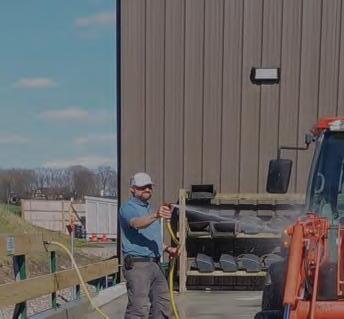

• Electric, self-charging autonomous mower
• Three models (300, 500, 500S) with multiple cutting head options
• 500S model handles up to 24 degrees of slope
• Height of cut range: 15mm–100mm
• Mows up to 75,000m² per charge
• No boundary wires needed
• Monitor remotely via desktop or mobile


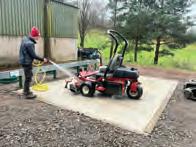

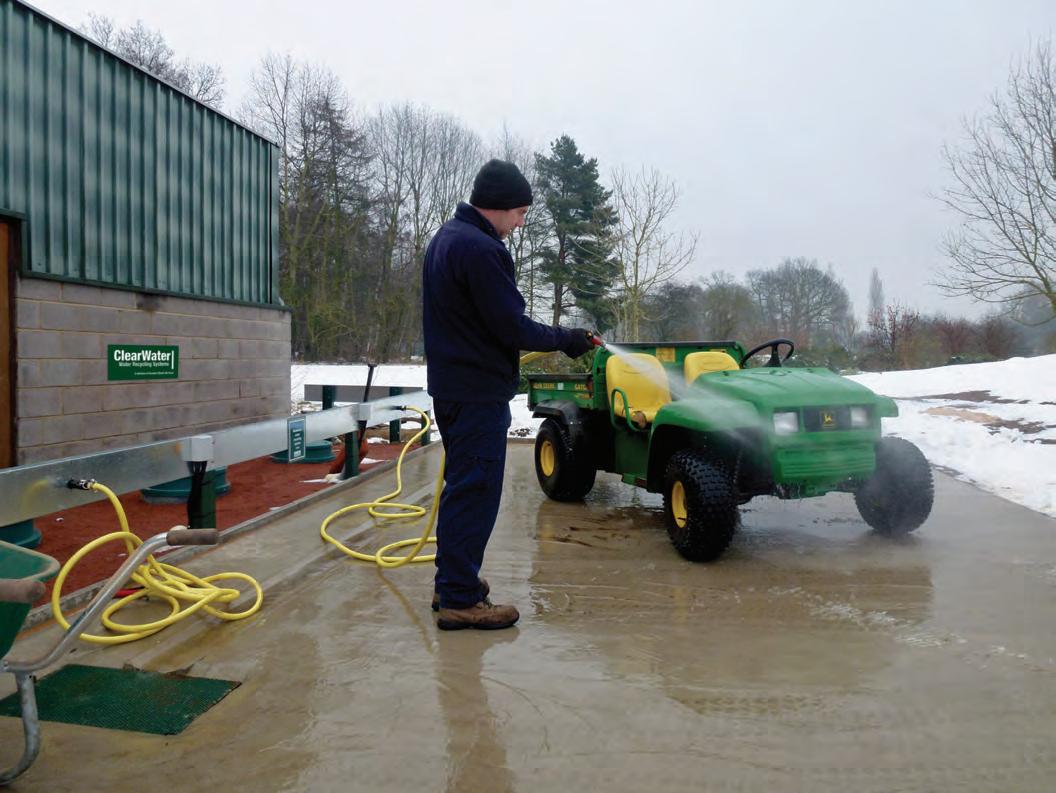



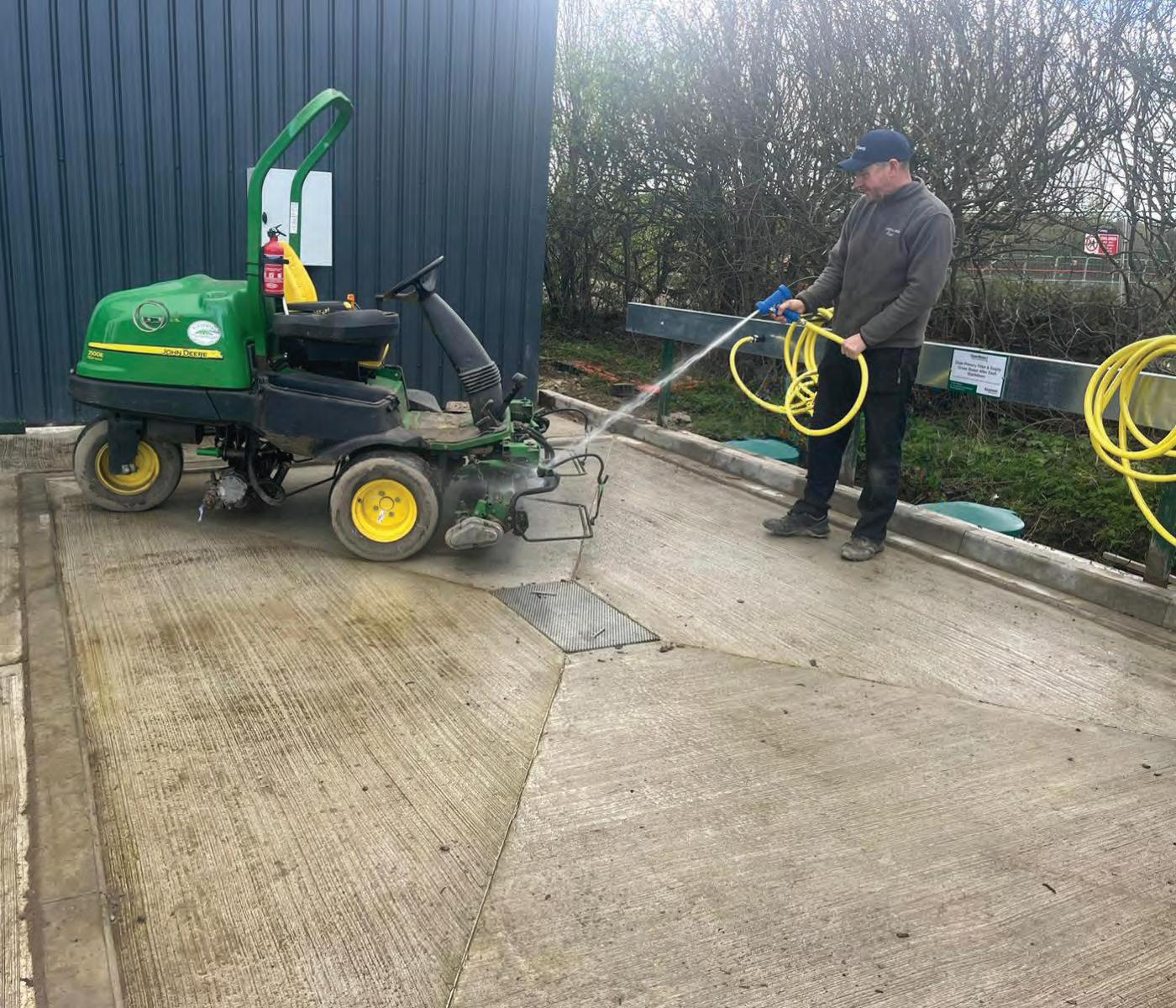
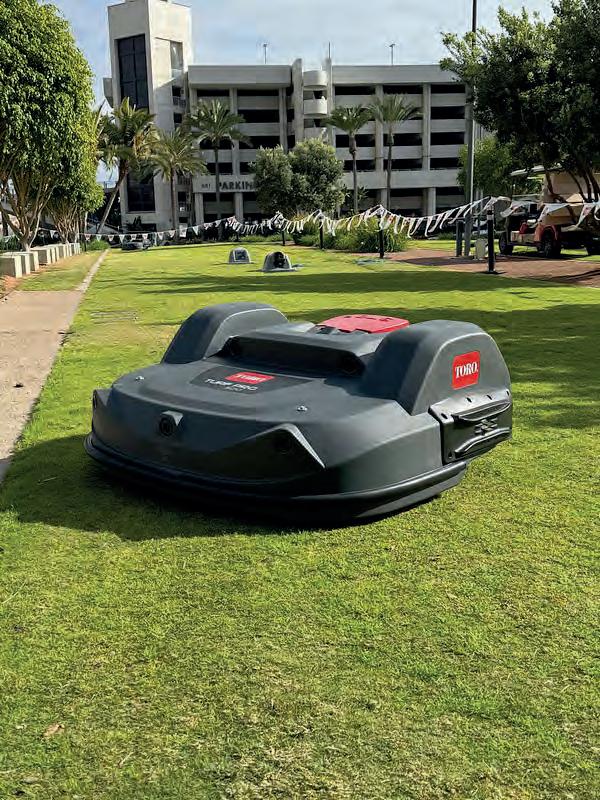
While the Turf Pro and Range Pro are genuinely autonomous, the GeoLink fairway mower requires supervision to support its activity. An operator can easily manage the mower while also getting on with other work – and that’s where these machines really shine: they add to teams, rather than replacing them.
Each mower is also packed with safety technology: LiDAR, radar, sonar, pressure sensors. If the mower detects an obstacle, it stops and alerts the operator. With usercontrolled work zones, mowing paths, no-go zones and cutting height presets, you always have total control.
• Fully electric, self-charging, and autonomous
• Collects up to 19,500 balls in 24 hours
• Quiet and efficient, perfect for driving ranges
• RTK and GPS for precise, consistent coverage
• No boundary wires required
• Control and monitor via app or desktop
Once operational, everything can be controlled remotely, whether that’s on a desktop in the office or on a phone out on the course. Thanks to Toro’s smart management technology, you can assign mowing patterns, adjust schedules, review diagnostics and check each machine’s status in real-time.
Perhaps the biggest win from autonomous technology is time. Turf teams have more freedom to focus on specialist tasks, and managers gain better oversight of what’s happening where.
And because these machines are electric or hybrid powered, there are less costs associated with fuel and servicing. That means fewer breakdowns, less risk of hydraulics leaking, lower running costs and a more sustainable overall operation.
Once the infrastructure for this technology is in place (for instance, chargers, RTK base station and software), it’s there to support future models, too. So whether it’s this generation or the next one, your club will be ready to embrace the future of turfcare.
This new generation of Toro machines does more than cut grass. It has the power to change how we think about turf management.
If your club is looking to future-proof operations, better allocate resources and support your team with smarter tools, now is the right time to explore autonomous mowing.


Want to explore how Toro’s autonomous range could support your team? Get in touch with Reesink Turfcare at 01480 226800 or visit reesinkturfcare.co.uk
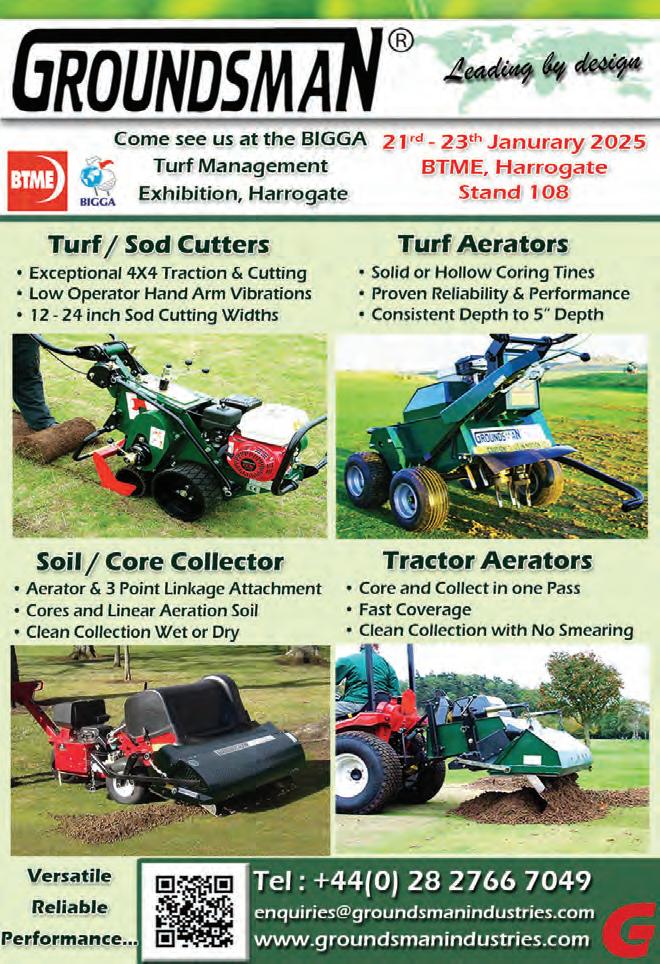














































Managing conflict takes resilience. It requires your ability to evaluate complex information, make evidence-based judgements and act professionally within the bounds of organisational and legal frameworks.
Aleader needs the insight to anticipate and manage conflict with confidence, find creative solutions and make tough decisions for the good of the individual, team and organisation.
Conflict can usually be grouped into the following categories:
• Poor communication
• Unfair treatment
• Unclear job roles
• Inadequate opportunities
• Poor work environment
• Bullying and harassment
Conflict typically occurs in escalating levels of seriousness. In the earlier stages, it’s easier to deal with the issues which are generated, and solutions are more quickly found. At the other end of the spectrum, once conflict has degenerated to a deeply hostile level, it becomes extremely difficult to resolve
issues, and external help may be needed to mediate a solution.
Conflict among workers in any team is inevitable. If it’s managed properly, it has the potential to be a catalyst for change and can have a positive impact on employee satisfaction and performance. Conversely, if unmanaged, conflict can seriously and negatively affect both job satisfaction and performance. Negative conflict in the workplace results in reduced productivity and time wasting, as anyone engaged in conflict focuses on personal issues, rumour spreading and diversion from the actual work itself. Conflict can turn the workplace into a war zone. This toxic environment leads many, who are conflict-averse, to become disillusioned and leave the organisation.
An organisation without conflict is probably apathetic. In contrast, conflict can sometimes signify involvement, commitment and caring. If understood and recognised, it can stimulate renewed and improved human relations. Without conflict, people seldom face and resolve

their problems. The existence of conflict in any team can therefore be functional and beneficial, as it increases staff cohesion on common goals, job satisfaction where everyone works better, produces more, take fewer days off and stay devoted to the organisation.
Dispute resolution is not an easy task. It is a complex process that requires careful consideration and skilful negotiation. Addressing conflicts and differences in a manner that satisfies all parties involved is paramount, demanding patience, understanding and an open mind to arrive at a mutually acceptable solution. It takes sensible thinking and a sense of fairness to bring two opposite sides to compromise in a civilised manner. Typically, there are five positions when handling conflict:
• Competing
Used by people who plan to win. They are assertive and un-cooperative. This method is characterised by the assumption that one side wins and everyone else loses. It doesn’t allow for diverse perspectives into a wellinformed total picture.
• Avoiding
This is when people just ignore or withdraw from the conflict. While this might seem the easy choice, people are not really contributing anything of value. When conflict is avoided, nothing is resolved.
• Accommodating
This strategy is where one party gives in to the demands of another. They are being cooperative but not assertive. This may appear to be a gracious, but like avoidance, it can result in unresolved issues.
• Collaborating
Here people are both assertive and cooperative. A team may learn to respect each other’s opinion allowing contribution, creating a shared solution that everyone can support.
• Compromising
Participants are partially assertive and cooperative. The concept is that everyone gives up a little bit of what they want, and no one gets everything they want. Compromise is perceived as being fair.
Competing
One party seeks to satisfy interest reagrdless of impact to other party
Compromise
Collaborating
Both parties win
Both parties win and give up something
Avoiding
One or both parties seek to surpress the conflict
Accommodating
One party yields the win to the other party
Finding the middle ground and working towards a compromise is by far the best way to improve relationships and achieve successful resolutions. Everyone is different, and the ability to adapt conflict resolution styles is a valuable leadership trait.
Recognising our own personal triggers is crucial in conflict resolution. By being aware of what provokes emotional responses, individuals can better manage their reactions, leading to more constructive outcomes. This self-awareness helps to avoid escalation and can empower individuals to maintain composure, communicate effectively and seek mutual understanding.
Here are ten common negative personal triggers that individuals might encounter, which if not carefully checked, can have a detrimental emotional impact when navigating difficult conversations:
1. Feeling unheard - When someone feels their perspective or emotions aren’t being acknowledged.
2. Personal attacks - Criticism that feels like an attack on one’s character or values.
3. Disrespectful tone - The use of condescending or sarcastic language.
4. Being interrupted - When someone regularly cuts into one’s speech or idea.
5. Broken promises - Commitments not being honoured, leading to disappointment.
6. Perceived injustice - Feeling like the situation is unfair or biased.
7. Past conflicts - Bringing up unresolved or past issues during the discussion.
8. Contradictions - When someone’s current actions don’t match previously expressed commitments.
9. Dismissiveness - When someone’s concerns are shrugged off or minimised.
10. Feeling trapped - The sensation of having no choice or control over the situation.
An organisation without conflict is probably apathetic. In contrast, conflict can sometimes signify involvement, commitment and caring.”
Article by Phil Helmn. Author of The Power of People
These triggers can vary in impact based on individual past experiences and sensitivities, hence recognising them can be beneficial for more effective conflict management. Usually, when dealing with higher authority, keeping respect for title is beneficial. In these circumstances, if there is a difference of opinion, introducing statistics to back up points of view are far more effective than personal opinions. When conflicting with colleagues on the same level, trading a favour or shared workload usually helps reach a mutually agreeable outcome. When dealing with a subordinate, adopting a sympathetic stance and understanding their view shows sensitivity before asking for common ground. Discovering compromise and collaboration isn’t easy to achieve – trust me, it takes considerable practice and patience and, from personal experience, arguably something that requires constant hard work and effort, but it’s well worth it in the end!

